December 1st, 2011
Corporate Tin Miner:
“We will continue to be aggressive explorers with multiple rigs focused on exploration for the foreseeable future.”
.
~ Venture Minerals (corporate tin miner from Perth), in its Mt Lindsay-Investor Presentation,
(Nov 2011), p.31
.
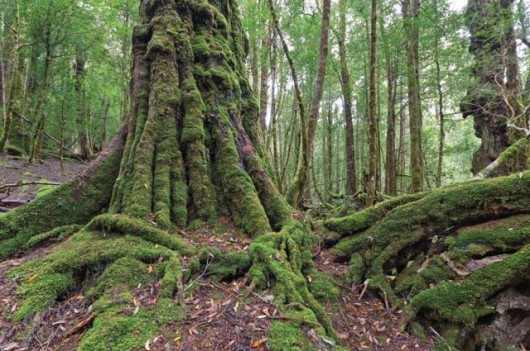 ‘The Tarkine’ – 430,000 hectares of ancient Tasmanian forest ‘The Tarkine’ – 430,000 hectares of ancient Tasmanian forest
Tasmania’s ancient Myrtle/Sassafras forest – threatened by loggers, logger ‘adventure tourism’, roads and now bloody tin mining!
[Photo by Peter Walton, Tasmanian Expeditions – Photo Gallery on The Tarkine, ^http://www.tasmanianexpeditions.com.au/index.php?section=photo_highlights&id=285742]
.
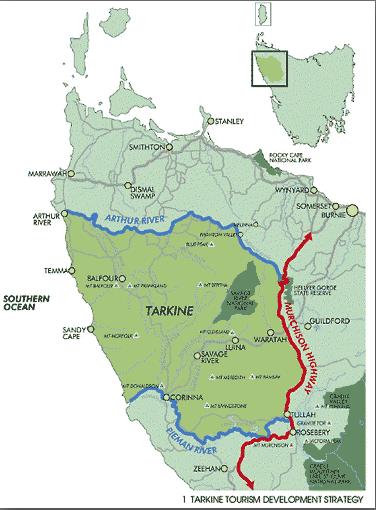 Cradle Coast Authority (CCA), North West Tasmania’s map
as part of a tourism development strategy. Cradle Coast Authority (CCA), North West Tasmania’s map
as part of a tourism development strategy.
.
A bid to restore emergency National Heritage protection to the Tarkine wilderness in Tasmania’s north-west has been launched by environmentalists to head off a ”Pilbara-style” mine in the rainforest. Several conservation groups lodged the nomination with the Environment Minister, Tony Burke, hoping he will count heritage values in his impending decision on the big Venture Minerals’ Mount Lindsay open cut project.
Emergency listings of The Tarkine have been granted four times since 2004!
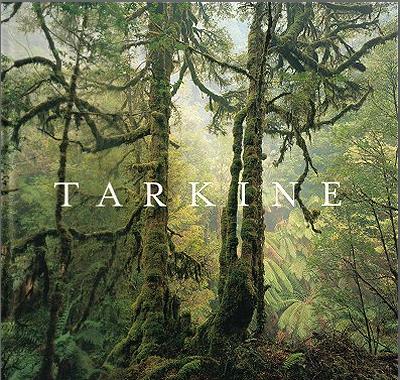 Moss-clad Sassafras (Atherosperma moschatum) trees in the Arthur River catchment near Waratah, Tarkine, Tasmania
(Photo © Ted Mead November 2003)
[Front Cover of the 2004 book, ‘Tarkine‘ edited by Ralph Ashton, and available from publishers Allen and Unwin,and just purchased by The Habitat Advocate.
Available at: ^http://www.allenandunwin.com/default.aspx?page=94&book=9781742372846]
Moss-clad Sassafras (Atherosperma moschatum) trees in the Arthur River catchment near Waratah, Tarkine, Tasmania
(Photo © Ted Mead November 2003)
[Front Cover of the 2004 book, ‘Tarkine‘ edited by Ralph Ashton, and available from publishers Allen and Unwin,and just purchased by The Habitat Advocate.
Available at: ^http://www.allenandunwin.com/default.aspx?page=94&book=9781742372846]
.
…but that’s not how the ‘Tin Men‘ see The Tarkine…
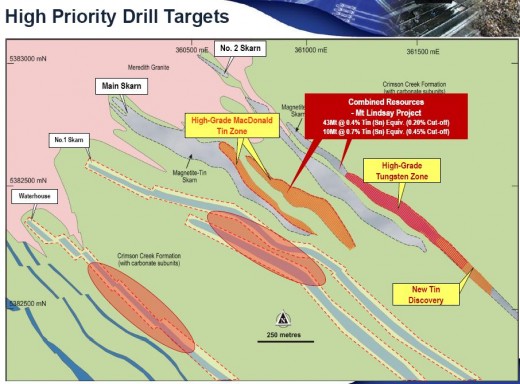 This is how the ‘Tin Men‘ see the Tarkine… for its tin and tungsten.
(Source: Venture Minerals’ Mt Lindsay-Investor Presentation, Nov 2011) This is how the ‘Tin Men‘ see the Tarkine… for its tin and tungsten.
(Source: Venture Minerals’ Mt Lindsay-Investor Presentation, Nov 2011)
.
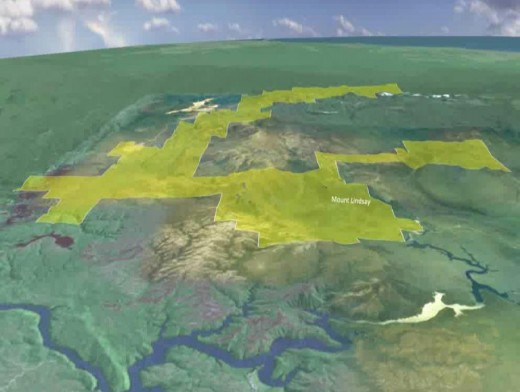 …and this is how the ‘Tin Men’ see the Tarkine… for the vast mining lease area they are happy to exploit and lay to waste. …and this is how the ‘Tin Men’ see the Tarkine… for the vast mining lease area they are happy to exploit and lay to waste.
(Source: Venture Minerals’ Mt Lindsay-Investor Presentation, Nov 2011)
.
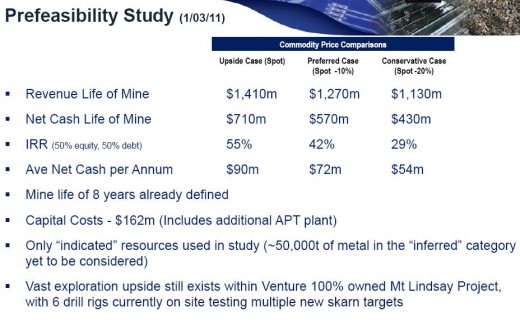 …and this is how the Tin Men see the Tarkine – for its ‘Super Mining Profits’ … 30 to 55% return! …and this is how the Tin Men see the Tarkine – for its ‘Super Mining Profits’ … 30 to 55% return!
(Source: Venture Minerals’ Mt Lindsay-Investor Presentation, Nov 2011)
.
The Mount Lindsay tin project is the largest of several mines planned around the Tarkine in an emerging new Tasmanian environmental battle. The Tarkine National Coalition said up to nine new open cut mines are in development there. Mr Burke allowed a previous emergency listing for the Tarkine to lapse a year ago when he said plans for a road through the wilderness were dropped. Environment groups objected because of what they said were increasing threats from mining.
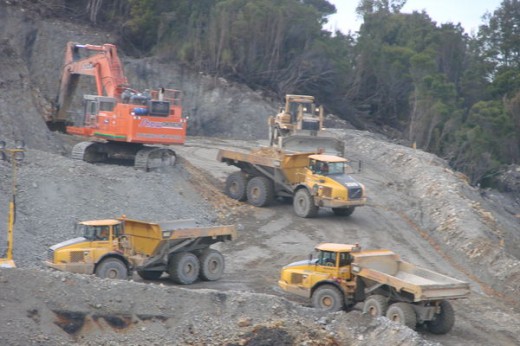 Corporate Miner ‘Metals X’ getting well stuck into a Tarkine rainforest hillside at nearby Mount Bischoff Corporate Miner ‘Metals X’ getting well stuck into a Tarkine rainforest hillside at nearby Mount Bischoff
.
The 430,000-hectare Tarkine region is undergoing a protracted assessment for future listing by the Australian Heritage Council. But because the wilderness now lacks any listing, Mr Burke is unable to consider heritage values in an approval of the Mount Lindsay mine under the Environment Protection and Biodiversity Conservation Act. Instead, his decision is likely to focus on protection of endangered species such as the Tasmanian Devil. The Tarkine is the wildest remaining stronghold for healthy devils, stricken across the rest of the island by a deadly facial cancer.
 The Tarkine is a refuge for healthy Tasmanian Devils to avoid the genocidal tumour disease
..but what could heartless commercial ‘Tin Men’ care?
Think of the ‘Super Mining Profits’ … 30 to 55% return! The Tarkine is a refuge for healthy Tasmanian Devils to avoid the genocidal tumour disease
..but what could heartless commercial ‘Tin Men’ care?
Think of the ‘Super Mining Profits’ … 30 to 55% return!
.
The Tarkine National Coalition spokesman Scott Jordan said yesterday:
”Companies, including Venture, are using the removal of the heritage protections to ramp up exploration activities including roading and drilling that are having a significant effect on the values of the area.”
.
The coalition was joined by the World Wildlife Fund, the Australian Conservation Foundation and The Wilderness Society in seeking the listing. An Australian National University environmental law specialist, Andrew Macintosh, said emergency listings had been granted four times since 2004, but Mr Burke was not compelled to respond to the request. In a statement, Mr Burke did not respond directly to the emergency listing request, but said he would continue meeting with different groups on issues surrounding the heritage listing of the Tarkine. [Editor’s note: in fact there has been one emergency National Heritage listing (Dec 2009 – Dec 2010), one National Heritage nomination (2004), three emergency National Heritage nominations (Nov 2009, Mar 2011 and Nov 2011), and two AHC recommendations (2003 and Sep 2010)… so what’s it bloody take to get the message through?]
.
[Source: ‘ Call for heritage listing of the Tarkine to head off tin mine‘, Sydney Morning Herald, 20111119, ^ http://www.smh.com.au/national/call-for-heritage-listing-of-the-tarkine-to-
head-off-tin-mine-20111118-1nndq.html]
.
.
‘Jobs, jobs, jobs’ justification – but all for mainlanders, foreigners and short-termers
.
Typically, this miner (Venture Minerals) relies on the standard jobs justification to exploit, dig up, pollute and destroy the Tarkine Wilderness for tin. Venture Mineral is promising 700 jobs! But of those , 500 jobs involve construction – so short term fly ins from the mainland and overseas only during construction phase. The remaining 200 jobs are promised for the mine’s operations. But miners don’t train locals. This is not about Tasmanian jobs. These 200 jobs will be sourced from similar mines on the mainland and indeed from overseas all on on Federal Labor’s 457 Visa (Australian worker displacement) Scheme. Just look at OZ Minerals at Rosebery.
457 Visas: ‘..for employers who would like to employ overseas workers to fill nominated skilled positions in Australia, to employ overseas workers for a period of between one day and four years.’
[Source: ^http://www.immi.gov.au/skilled/skilled-workers/sbs/]
.
Venture Minerals is Perth-based at 181 Roberts Road Subiaco, another West Australian corporate miner exploiting Tasmania and taking the profits offshore. Venture Minerals forecasts $1 billion in revenue but it won’t go to Tasmanians. It will go back to West Australia and to its rich mine shareholders. Typically mining is eco-rape, pillage and plunder – wam, bam, thank you mam, then pissing off back to where one came, leaving another tin moonscape like Mount Bischoff.
Look at the mining legacies across Tasmania left as moonscapes:
 Nearby Mount Bischoff Tin Mine – wam, bam, thank you mam! Nearby Mount Bischoff Tin Mine – wam, bam, thank you mam!
.
- Kara Mine in Hampshire
- Mount Lyle’s sulphuric moonscape
- Henty Mine
- Briseis Mine at Derby
- Pioneer Mine on Bradshaws Creek
- Anchor Mine on Blue Tier
- Gladstone Mine
- Coles Bay Mine
- Ben Lomond Mine
- St Paul’s River Mine
- Flinders Island Mines
- Mount Heemskirk
- Mount Balfour
- Renison Bell
- Stanley River
- Mount Cleveland
- Cox Bight
- Melaleuca
- etc
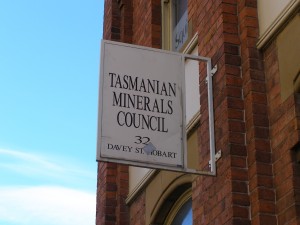
And of course the Tasmanian Minerals Council backs mining in The Tarkine. And of course it opposes national heritage listing of the Tarkine. The Tasmanian Minerals Council is only about the financial bottom line, exploitation of ore and perpetuating its own existence.
 The Tasmanian Minerals Council claims that there are “already enough layers of protection across the Tarkine region, where about 80% of the land has been put in multiple use reserves that allow mining“. The Tasmanian Minerals Council claims that there are “already enough layers of protection across the Tarkine region, where about 80% of the land has been put in multiple use reserves that allow mining“.
What ‘layers of protection’? If 80% of the Tarkine is reserved form mining, how can that be for protection? – for protection of mining profits and royalties perhaps.
So Tony Burke, if you’re not to pre-occupied with resolving the future of the Murray-Darling, what time are you allocating for Tasmania’s ancient Myrtle forests?
.
.
.
‘Tasmania’s Tarkine wilderness is one of the world’s largest temperate rainforests.
This vast expanse is a wilderness wonderland of wild rivers, dramatic coastal heathlands, button grass plains, bare mountains, ancient Huon pines, giant eucalypts and myrtles and extraordinary horizontal scrub.
It is home to rare and endangered birds – like the Orange-bellied parrot and the White goshawk – and countless animals such as the Eastern pygmy possum. This superbly illustrated book captures the beauty of this unique wilderness.’
.
[Source: ^http://www.andrewisles.com/all-stock/publication/tarkine]
.
Orange-bellied Parrot
 ‘Here at Melaleuca, six days’ walk from the nearest road,
such moments of peace are typically broken by bird calls,
including the distinct buzzing of the orange-bellied parrot’.
.
[Source: ‘Scientists Race To Rebuild Parrot Population’, by Peter Ker, Sydney Morning Herald, 20110207, ^http://www.globalanimal.org/2011/02/07/scientists-race-to-rebuild-parrot-population/29032/] ‘Here at Melaleuca, six days’ walk from the nearest road,
such moments of peace are typically broken by bird calls,
including the distinct buzzing of the orange-bellied parrot’.
.
[Source: ‘Scientists Race To Rebuild Parrot Population’, by Peter Ker, Sydney Morning Herald, 20110207, ^http://www.globalanimal.org/2011/02/07/scientists-race-to-rebuild-parrot-population/29032/]
.
Current status:
‘The Orange-bellied parrot (Neophema chrysogaster) is one of 18 birds listed as endangered under the Tasmanian Threatened Species Protection Act 1995. It is also listed as endangered under the Federal Act and has the dubious honour of being one of the most endangered birds Australia wide.
Why is it endangered? The Orange-bellied parrot is endangered because it is so rare (only 200 birds left) and its habitat is quickly disappearing.
.
There are only about 50 breeding pairs of this bird left!
..but what could heartless commercial ‘Tin Men’ care?
Think of the ‘Super Mining Profits’ … 30 to 55% return!
.
‘…It is a breeding endemic of Tasmania, which means that it only breeds in Tasmania. In fact it only breeds in one place in Tasmania and that is in our Southwest National Park. It arrives here in summer, nesting in eucalypt tree hollows adjacent to the parrot’s feeding grounds of extensive coastal buttongrass plains.’
.
[Source: http://www.dpiw.tas.gov.au/inter.nsf/webpages/bhan-54g3c5?open]
.
Tags: 457 visas, Cradle Coast Authority, Environment Minister, high priority drill targets, Melaleuca, Metals X, Mount Lindsay, Orange-bellied Parrot, Pieman River, super mining profits, Tarkine Tourism Development Strategy, Tarkine Trails, Tarkine wilderness, Tasmania, Tasmanian Devil, Tasmanian Minerals Council, The Tarkine, tin man, tin men, tin mine, Tony Burke, tungsten mine, Venture Minerals, wam bam thank you mam
Posted in Birds (Australian), Tasmania (AU), Tasmanian Devils, Threats from Mining, Threats to Wild Tasmania | 8 Comments »
Add this post to Del.icio.us - Digg
Leave a Reply
You must be logged in to post a comment.
November 30th, 2011
This article was initially published by Tigerquoll 20090622 on CanDoBetter.net in the aftermath of the devastating Victorian bushfires that climaxed on 7th February 2009:
.
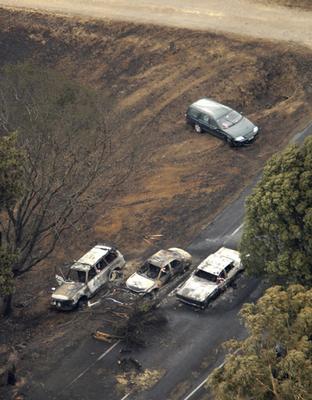 Last ditch huddling together in cars didn’t work
(Chum Creek)
Last ditch huddling together in cars didn’t work
(Chum Creek)
.
The Victorian Premier Brumby’s Royal Commission into the January-February 2009 bushfires is a mere incident review. If Victoria is to be protected from firestorms in future, it should undertake a root cause analysis, including the numerous past investigations into bushfires, with a view to achieving a cultural shift in rural fire fighting methods, resourcing and emergency management and into ecology management, housing approvals in bushfire prone areas, building design in bushfire prone areas, bush arson criminology and into serious resourcing of rural fire management.
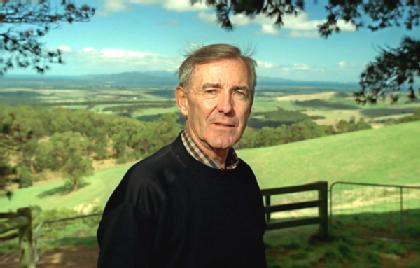 A familiar media icon of Victorian television news for over a decade – he and his family, like those around him, had a right to a safe lifestyle in beautiful rural Victoria
(This editor grew up watching Nine News, as part of our family routine for many years, and I remain still personally affected by his awful tragedy). A familiar media icon of Victorian television news for over a decade – he and his family, like those around him, had a right to a safe lifestyle in beautiful rural Victoria
(This editor grew up watching Nine News, as part of our family routine for many years, and I remain still personally affected by his awful tragedy).
.
Indeed, given the repeated history of bushfires across Australia and the repeated uncontrolled nature of many of these leading to extensive property damage, the loss of thousands of livestock, widespread ecological destruction, the human lives lost and injuries, and the massive costs incurred every year, the scope of the enquiry should be escalated to a national level.
But the Victorian Commission’s terms of reference focuses on the immediate causes and circumstances of the 2009 Victorian Bushfires. It focuses on the immediate management, response and recovery. This is a start, but the real start occurred in 1939 with the shock of Black Friday. It lead to the Stretton Enquiry, but many large and damaging firestorms have occurred since – so the Stretton Enquiry showed that lessons were either ignored or the application of those lessons were ineffective. The Esplin Inquiry of 2003 identified striking parallels between 1939 and 2002-3 bushfires. Now we have the 2009 Bushfires, but each investigation is disconnected from the previous one, almost as if to intentionally ignore history and any prior lessons learnt. Interstate and overseas, many major bushfires and their subsequent investigations have amassed research, insight and lessons. Why limit the investigation to one event?
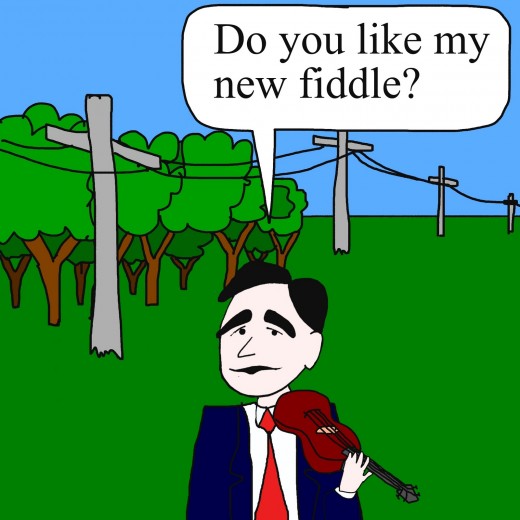 Victorian Premier’s complicity in under-preparation, and precious nothing’s been done since Victorian Premier’s complicity in under-preparation, and precious nothing’s been done since
.
Incident investigation will uncover causes and flaws and will likely make specific recommendations in the hope of preventing similar incidents. But root cause analysis goes beyond identifying the symptoms of a problem. But the Commission has not started with identifying the problem.
Let’s say that that at the core is the problem of preventing ignitions becoming firestorms.
- What are the causes of uncontrolled ignitions in the bush?
- Where are they typically lit?
- How are ignitions detected by fire authorities?
- What is the time lapse between ignition and detection?
- What is the time lapse between detection and response and eventual suppression?
- Which causes and interventions would mitigate the risk of these ignitions developing into uncontrollable firestorms?
- Are the ignition detection tools adequate?
- Are the communications tools adequate?
- Do we have the right tools and trained personnel in the right places to effectively respond?
- Is the entire detection, response and suppression system sufficiently integrated to deal with multiple ignitions in extreme conditions across the State at the same time?
- How would this be achieved?
- What budget would be required to have such resources and technology in place to achieve this standard?
- Is the problem indeed too big for Victoria by itself to adequately deal with and so is the problem in fact a national one?
- How would a satisfactory solution be achieved without causing other problems like ecological damage and local wildlife extinctions?
.
Then implement the recommendations and scientifically monitor their effectiveness. But the Commission is looking at what caused the specific ignitions, what damage the specific bushfires caused and specific responses. It will conclude what specifically should have been done in these specific incidents. It will lead to a blame game that will solve nothing. Subsequent ignitions if not predicted, detected, responded to and suppressed to prevent firestorms, will likely have different circumstances in different locations.
- So how will the problem have been solved by this Royal Commission?
- How will the Victorian Royal Commission prevent bushfire history repeating itself?
.
What a useless fabricated enquiry, another one in the litany of government rural community betrayal!
.
.
Leave a Reply
You must be logged in to post a comment.
November 29th, 2011
This article was initially published by Tigerquoll 20090621 on CanDoBetter.net in the aftermath of the devastating Victorian bushfires that climaxed on 7th February 2009:
.
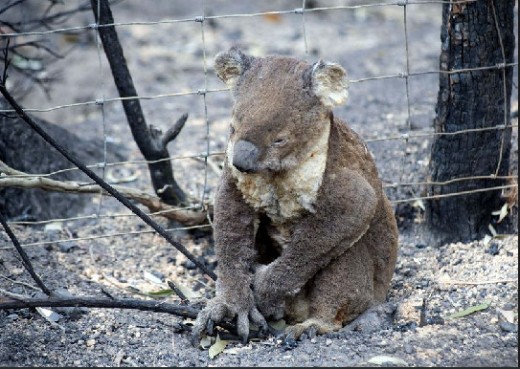 A forgotten victim of bushfire
A forgotten victim of bushfire
.
The analogy of the Titanic ocean liner disaster of 15th April 1912 is apt in relation to rural communities entrusting those in charge to be able to deal with public/national emergencies. The public trusted the Titanic met government standards. But 2,223 people boarded and 1514 died from the iceberg collision. Government standards were later revealed as substandard.

Public trust in government is appropriate (it’s why we pay our bloody taxes), but government systemically neglects its responsibility and abuses that public trust. Government has the nerve to entice volunteer members of the community to do its dirty work – aka the CFA. So individuals have given up on their government to be able to respond adequately to emergencies (bushfires, floods, droughts, etc) feel compelled to take measures themselves. Building a bunker is a vigilante response. I’m not saying its not a constructive response, but it is a consequential reaction of government failing to protect bushfire-prone communities. It’s like residents losing faith in the police and feeling compelled to being vigilantes. It’s akin to Titanic passengers bringing along their own liferafts.
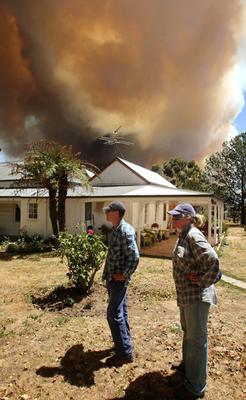 ‘Stay or Go‘? ‘Stay or Go‘?
.
To attribute blame on climate change ignores the role of government and in the case of the 2009 Victorian Bushfires lets government get away with manslaughter – literally.
Look into the history of the causes of the Titanic sinking and one can draw many comparisons with the failures of Emergency Management Australia in how it failed to protect life, property and ecological values from the bushfires across Victoria last January and February. The root causes of the (a) 1914 Titanic’s sinking and (b) the loss of 1514 lives were: management culture, poor contingency planning, design flaws, poor governance (e.g. inadequate safety regulations), poor operational response, amongst others.
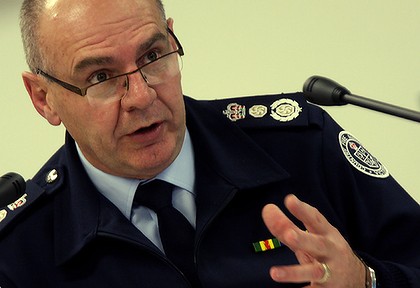 Victorian CFA Chief during Victoria’s tragic 2009 bushfires Victorian CFA Chief during Victoria’s tragic 2009 bushfires
The root causes of (a) the 2009 Victorian Bushfires being allowed to grow into unstoppable infernos and (b) the tragic loss of 127 lives were: management culture, poor contingency planning, design flaws, poor governance (e.g. inadequate safety regulations), poor operational response, amongst others.
The basic question is what emergency strategy was adopted to deal with the Victorian bushfires and why didn’t it work adequately to achieve a best practice outcome – no lives lost, no houses lost, no wildlife killed?
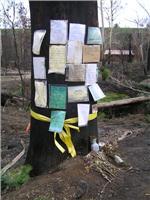 Words from Strathewen
. Words from Strathewen
.
A root cause of the firestorms being allowed to become firestorms from multiple ignitions is that insufficient dedicated resourcing was provided to deal with the hundreds of ignitions in extreme tinder dry conditions with high winds. The government agencies (CFA, et al) knew the fire index was 300, that this was the worst on record, yet did stuff all to prepare or warn the public. There was a wind change forecast, yet this was not communicated to residents. Relying upon volunteers to drive fire tankers to remote ignitions is proven as ineffective as pissing into a wall of flame.
The 1940’s fire fighting thinking needs to be overhauled – by the time the 000 call is received, the volunteers are called in, drive their fire trucks out to an ignition, two hours later, that ignition has spotted into a fire front and its too late! Happens all the time!

Trapped and no hope
.
Another root cause is government allowing people to build in the bush in extreme fire risk locations and in houses that are not bushfire resistant. The tragedy is that after the Royal Commission, the likely response is to incinerate the bush like no tomorrow – destroy the natural environment that people yearn to be near. It will fail to recognise the complexity of the causes and the solutions and will advocate a knee-jerk – troglodyte (‘ugg ugg’) burn the lot approach. The Commission’s verdict will fuel Brumby’s Final Solution to prescribe Victoria back to the Stone Age.

A key question is what is government leadership in fire fighting to do – i.e Emergency Management Australia? How about four fundamental approaches:
- Introduce world-leading scientific research and monitoring of bushfire threats – climate and weather conditions, bush conditions, arson investigation, lightning, and integrate these with bushfire fighting.
- Obtain state-of-the-art monitoring of bushfire-prone areas across South Eastern Australia to the point where ignitions and plumes in the remotest of locations can be detected within minutes of them starting, feeding this data to a central database and to a standby emergency professional and national response unit.
- Employ military-esque emergency services professionals to respond to ignitions within an hour of starting – airborne professionals, not a volunteer ‘dads army’ sitting in trucks.
- Resource Australian Firefighting with serious air resources to combat bushfires with military efficiency and scale. A chunk of Rudd’s $26 billion budget on Defence should have gone to setting up a national airborne fire fighting response division and an integrated satellite detection, alert and response system/unit. Isn’t this defence at home?
.
Unless the above is done, nothing will change, but now that Titanic has sunk (Victorian Bushfires killed 173 human lives, cost billions in property losses and contributed to many local wildlife extinctions) we no longer should be shocked when it happens all over again.
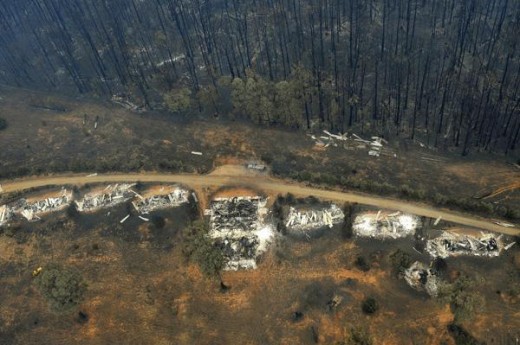 Kinglake aftermath – homes and lives incinerated Kinglake aftermath – homes and lives incinerated
.
As for bunkers, no government will guarantee a bunker to protect life ever.
One must attribute responsibility to the top of government, down. I hold Kevin Rudd accountable for the next bushfire tragedy and we are six months before next January.
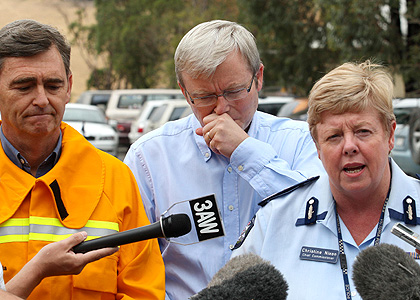 Brumby, Rudd, Nixon- the ultimate emergency leadership responsible for the Victorian Bushfires outcome of 2009 Brumby, Rudd, Nixon- the ultimate emergency leadership responsible for the Victorian Bushfires outcome of 2009
Ultimate government leadership has ultimate responsibility for public emergency
– the resourcing, the planning, the risk recognition, the mitigation, the response, the compensation.
.
In bushfire management, political will continues to be negligent.
.
.
Tags: bush fires, CFA, Emergency Management Australia, emergency services, Kevin Rudd, Kinglake, Premier Brumby, Stay or Go, Strathewen, tigerquoll, Titanic, Victorian Bushfires 2009, wildlife victims of bushfire
Posted in Threats from Bushfire | No Comments »
Add this post to Del.icio.us - Digg
Leave a Reply
You must be logged in to post a comment.
November 25th, 2011
‘It’s only bush, she’ll be right’ – famous last words by bushfire management, and not a wildlife zoologist among them.
 …was …was
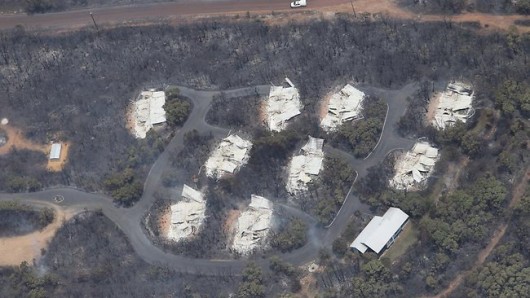
Part of the human cost of State-sanctioned Arson
Margaret River Fire 2011.
.
“All my bits and pieces that make me are gone,” says Marjorie Stewart, who lost her home in the raging bushfire in Margaret River.
.
Here we go again. Every year, prescribed burns get out of control somewhere across Australia, yet the State culture of lighting fires to mitigate wildfires continues unquestioningly. No thought is given to the consequential killing of Australian wildlife and the destruction of ever-shrinking islands of habitat. To wildlife it is arson. Is it any wonder why Australia has the world’s worst record in local fauna extinctions.
But it is when human lives and human property are damaged that bushfires make the human headlines. The current Margaret River Bushfire’ is a consequence of yet another ‘escaped burn’ in the litany of bushfire management’s perverted ‘strategic bushfire protection‘. Some protection! Lighting bushfires is arson. Letting a bushfire burn remotely overnight for 80 nights is grossly reckless neglect. The consequential human cost and community cost is the responsibility of the State.
Local farmer near the WA town of Denmark Tony Pedro is angry at what he says are government-sanctioned burns which get out of control and threaten private property. Mr Pedro says it is time authorities in WA changed their fire management policy from one of ignition to suppression.
“In summer the community doesn’t light fires. You know the farmers don’t light fires and if someone does light a fire they’re called an arsonist.”
[Source: ‘Fires in Denmark contained and downgraded’, ABC, 20111125, ^http://www.abc.net.au/news/2011-11-25/denmark-fires-downgraded/3694428?section=wa]
.
.
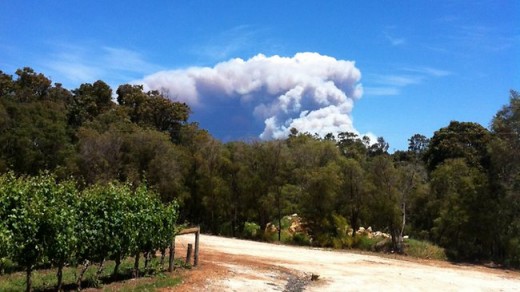
Margaret River Bushfire, 2011
.
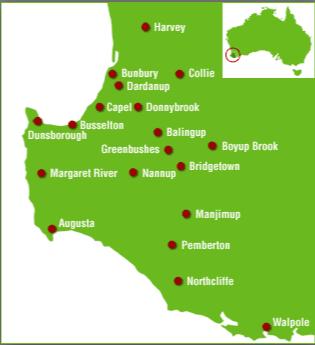 Margaret River, Western Australia
situated about 230km south of Perth
[Source: http://www.mysouthwest.com.au/Tourism]
. Margaret River, Western Australia
situated about 230km south of Perth
[Source: http://www.mysouthwest.com.au/Tourism]
.
The West Australian Government’s Department of Environment and Conservation (DEC) is the State authority delegated the custodial responsibility for protection and conservation of the environment of Western Australia. This includes managing the State’s national parks, marine parks, conservation parks, State forests and timber reserves, nature reserves, marine nature reserves and marine management areas. Leading its key objectives is the requirement to conserve biodiversity – ‘Protect, conserve and, where necessary and possible, restore Western Australia’s biodiversity’. [Source: ^http://www.dec.wa.gov.au/content/section/29/2035/ (About Us)]
Yet, every three years DEC lights bushfires across the State, euphemistically termed ‘prescribed burns‘ under its Master Burn Planning process, that it has convinced itself..is designed for:
- ‘Biodiversity conservation through application of scientifically based fire regimes to maintain and protect native flora and fauna communities and/or habitats’
- ‘Community protection-protection of human life, property, public assets, parks, water catchments, timber values and plantations’
- ‘Silvicultural burns for regeneration of native forests following timber harvesting’.
[Source: DEC website, ‘Planning for prescribed burning’, ‘Proposed Burn Program’, ^http://www.dec.wa.gov.au/content/view/128/1870/1/3, accessed 20111125]
.
You see, Australian native vegetation burns, so burning it must be good for it. As for the wildlife, well we think they come back, but we don’t really check. DEC’s Master Burn Planning for the three year period 2011-2014 began in Spring.
.
.
Tue 6th Sep 2011: The ignition?
.
The Margaret River ‘prescribed burning’ was reportedly lit on Tuesday 6th September, two and a half months ago by DEC as a prescribed burn! Exactly when or where has not been made officially public by DEC. Another report claims that a spokesperson for Environment Minister Bill Marmion said:
“The Department of Environment and Conservation were not undertaking any prescribed burns in the Augusta-Margaret River area. However, a prescribed burn was commenced in the Leeuwin-Naturaliste National Park on the 10th of November and completed yesterday. We understand that this fire is a result of winds picking up an ember from a hot spot and carrying it over the burn boundary today.”
.
The ‘extent of the indicative burn programs for the south-west regions for the six seasons for spring 2011 to autumn 2014’ specific to the Margaret River area is shown on the following map extract . [Read full PDF map]
.
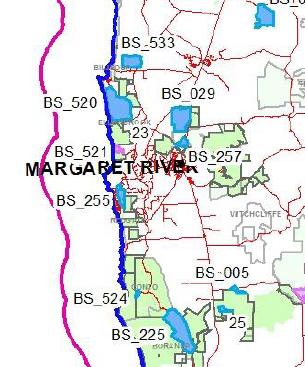
DEC’s ‘Indicative Burn Plans for South West (Spring 2011)
– Blackwood and Wellington districts‘
(Blue areas are targeted for ‘strategic bushfire protection’)
.
Anecdotal evidence from various online media reports suggests that DEC’s prescribed burning was occurring within the nearby coastal Leeuwin-Naturaliste National Park.
So DEC, the custodian of National Parks in Western Australia, set fire to the National Park. So it is likely the magnificent tall stands of Karri and Jarrah forest, that characterise areas of the Park, have been burned? The coastal scrub-heath and large peppermints and banksias which provide habitat to a variety of native mammals including the Southern Brown Bandicoot, Western Grey Kangaroos, Common Ringtail Possum and Brush-tailed Wallabies – have they been burned too? What of the native birds of the Park including the Red-eared Firetail, White-breasted Robin, Rock Parrot and Emu? How much of this important dedicated wildlife sanctuary has been incinerated and disclocated by the custodian charged to protect it? And why?
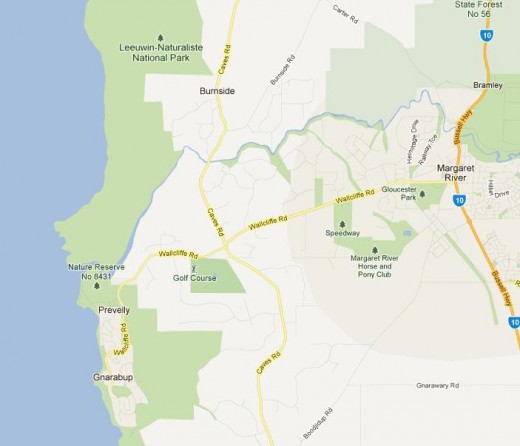 Map of Margaret River and surrounds
The Leeuwin-Naturaliste National Park is where the bushfire was apparently started,
then the fire seems to have been fanned across the Margaret River into the villages of Prevelly and Gnarabup Map of Margaret River and surrounds
The Leeuwin-Naturaliste National Park is where the bushfire was apparently started,
then the fire seems to have been fanned across the Margaret River into the villages of Prevelly and Gnarabup
(Google Maps)
.
 Close up satellite map of the Nature Reserve and coastal village of Prevelly
[Source: http://www.maplandia.com/australia/western-australia/augusta-margaret-river/margaret-river/] Close up satellite map of the Nature Reserve and coastal village of Prevelly
[Source: http://www.maplandia.com/australia/western-australia/augusta-margaret-river/margaret-river/]
.
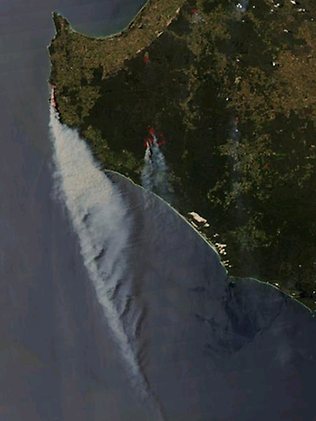 High level satellite photo shows a clear plume of smoke along the coast indicating a strong NNW wind.
[Source: Jeff Schmaltz and LANCE/EOSDID Rapid Response Team, NASA] High level satellite photo shows a clear plume of smoke along the coast indicating a strong NNW wind.
[Source: Jeff Schmaltz and LANCE/EOSDID Rapid Response Team, NASA]
At the time of compiling this article (20111125), no clear and definitive map of the progress of the bushfire zone was available online. The following map is indicative, but it is known that the coastal village of Prevelly to the south was affected, so not too much reliance can be placed upon this aerial map.
 . .
Weather Forecasts?
.
A key factor in bushfires is weather – minimum and maximum temperatures, wind direction, wind speed, maximum wind gust strength, relative humidity, anticipated wind changes, precipitation, etc. What as the weather forecast at the Time? Over 80 days the weather must have varied – the winds, the temperature, yet the prescribed burn was allowed to perpetuate. Weather archival information is available from the Australian Bureau of Meteorology (BOM) for a small fee. An example of yesterday’s weather forecast for the south western area where Margaret River is situated is limited but reads as follows:
.
District Forecasts for Western Australia:
IDW13000
Australian Government Bureau of Meteorology
Western Australia
DISTRICT FORECASTS FOR WESTERN AUSTRALIA
Issued at 4:20pm WST on Thursday the 24th of November 2011
for tonight and Friday with outlooks for Saturday
—————————————————–
IDW1300003
SOUTHWEST:
Remainder of Thursday: Partly cloudy. Becoming humid. Moderate to fresh NW’ly
winds, easing during the evening.
Friday: Areas of morning drizzle in the southwest. Moderate W/SW winds.
Fire Danger:
COASTAL LOW-MODERATE
INLAND LOW-MODERATE
Outlook for Saturday : Isolated areas of drizzle in the southwest in the
morning.
Temperatures for Friday (Minimum Maximum)
Bunbury 17 26
Busselton 15 26
Margaret River 15 24
Bridgetown 16 26
Collie 15 28
Manjimup 16 26
——————————————————-
IDW1300004
SOUTH COASTAL:
Fire Weather Warning issued for Stirling-Inland subdistrict.
Remainder of Thursday: Partly cloudy. Moderate N/NE winds.
Friday: Areas of morning drizzle in the far west. Isolated showers and
thunderstorms developing during the afternoon. Moderate W/SW winds.
Fire Danger:
Stirling Coastal VERY HIGH
Stirling Inland SEVERE
Outlook for Saturday : Isolated areas of drizzle in the far west in the morning. Isolated showers and thunderstorms over the central and eastern parts in the afternoon.
Temperatures for Friday (Minimum Maximum)
Albany 17 27
[Source: ^http://www.bom.gov.au/wa/forecasts/swarea.shtml]
.
 Presuming the fire danger was rated low-moderate,
on 6th September off DEC went and lit bushfires around Margaret River Presuming the fire danger was rated low-moderate,
on 6th September off DEC went and lit bushfires around Margaret River
.
.Clearly DEC’s prescribed burn by yesterday (24th Nov) the bushfire(s) around Margaret River had been burning for some 80 days.
- Why?
- When had they got out of control?
- What measures were put in place to handle increase in wind speed?
- Clearly it was imprudent to allow a bushfire continue for 80 days. When had the decision to suppress been taken?
- DEC had decided to continue the prescribed burn in the National Park as recently as Sunday 20th November, despite high temperatures and strong winds being forecast for later in the week. *
*[Source: ‘WA Premier admits failures on Margaret River fire‘, by Nicolas Perpitch and Paige Taylor, The Australian, 20111125, ^http://www.theaustralian.com.au/national-affairs/politics-news/wa-premier-admits-failures-on-margaret-river-fire/story-fn59nqld-1226205457331]
.
When prescribed burns escape and get out of control (which across Australia is all too frequent), this is more than a tactical misjudgment. It is becomes a bush arson gamble gone wrong. Then more than 30 homes are destroyed as a direct consequence, this is gross culpable negligence.
How dare Premier Colin Barnett then offer those who lost their homes in the Margaret River bushfire a measly $3000 compensation each from the State government. Add three zeros – to each affected household! All affected by loss should collectively seek redress and compensation for all economic loss and trauma and file a class action against DEC and the State Government. Dare to set a precedent! Hip pocket strategy is the best way to put an end to government negligence!
Incident controller Roger Armstrong said the burns escaped authorities’ control 23rd November 2011. The prescribed burn that had led to the present disaster started on September 6, with 60 burns undertaken in the past month. “I want to reinforce with you that we did not ignite a prescribed burn on a serious fire danger day,” Mr Armstrong said. “It was ignited quite a considerable time before that.” [Source: ‘DEC denies Margaret River fire negligence‘, by Courtney Trenwith and Aja Styles, WA Today, 20111124, 12:02 PM, ^http://fw.farmonline.com.au/news/state/agribusiness-and-general/general/dec-denies-margaret-river-fire-negligence/2369712.aspx]
.
.
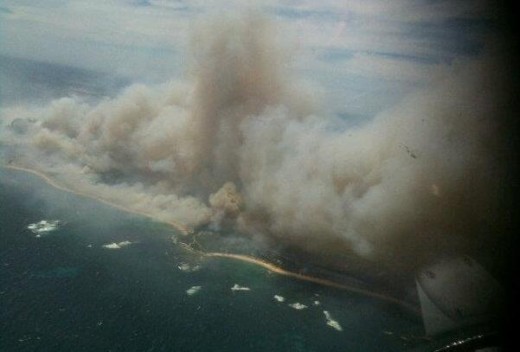
Related Events:
.
During September, DEC’s prescribed burning spring was in full swing across Western Australia. Opposition Leader Eric Ripper questioned whether DEC had been under political pressure to complete an extraordinary number of prescribed burns before the official start of the bushfire season on December 1. [Source: ‘WA Premier admits failures on Margaret River fire’, by Nicolas Perpitch and Paige Taylor, The Australian, 20111125, ^http://www.theaustralian.com.au/national-affairs/politics-news/wa-premier-admits-failures-on-margaret-river-fire/story-fn59nqld-1226205457331].
DEC Principal Fire Operations Manager, Terry Maher, has more or less confessed that DEC fast-tracked this planned prescribed burn. Maher has said that wet weather in October prevented the Department from concluding the prescribed burn sooner.
.
“It would have been absolute negligence if we hadn’t had a crack at trying to complete it because the result would have been the same,” he said.
“It was running around. We had to complete that burn.”
[Source: ‘ Cool change hoses down Margaret River fire‘, 20111125, ABC, ^ http://www.abc.net.au/news/2011-11-25/cool-change-hoses-down-fires/3695026?section=wa]
.
On 15th September, the biggest controlled burn in WA’s history was reported underway on the Nullarbor plain, with DEC setting fire to 660,000 hectares (80km x 80km) of native grasslands. [Source: ‘Nullarbor goes up in smoke‘, ABC Rural, by Tara De Landgrafft, 20110915, ^http://www.abc.net.au/rural/wa/content/2011/09/s3318617.htm?site=perth]. The bushphobic logic was that recent rains had generated natural regrowth, which is demonised as bushfire ‘fuel’, so best burn it in case it burns. No thought was given to the consequential killing of vulnerable fauna native to the Nullabor grasslands such as the Yitjarritjarri (Notoryctes typhlops), Sandhill Dunnart (Sminthopsis psammophila), Bush Stone-curlew (Burhinus grallarius) and Malleefowl (Leipoa ocellata). Interesting how the same logic applied to flammable native vegetation is not applied to flammable pine plantations. Why? The latter is valued, the former is not.
‘It’s only spinifex, she’ll be right’
.
The same day, the WA State Government’s Emergency Services Minister Rob Johnson announced that 80% of Western Australia was at heightened risk of bushfire due to regrowth of native vegetation and so urged home owners ‘to be prepared‘. In the preceding February around the Perth Hills towns of Kelmscott and Roleystone, 72 homes had been destroyed by bushfire. Johnson went on to reassure the public stating that ‘authorities are adequately prepared for the season ahead after considering recommendations from recent bushfire reviews and implementing changes’. [Source: ‘Warning to be prepared for increased bushfire risk’, ABC Rural, 20111015, ^http://www.abc.net.au/news/2011-10-15/bushfire-preparation-wa/3573018/?site=perth]. In October, Johnson had further publicly declared “I don’t think we’ve ever been so well prepared as we are at this moment in time.” [Source: ‘A dire bushfire season ahead: how will it be tackled?‘, by Natasha Harradine, ABC Rural, 20111109, ^http://www.abc.net.au/news/2011-11-09/bushfire-preparedness-feature/3655174]
.
Throughout September, October and right up until 23rd November 2011, no mention can be found online of any news about the supposed continuing prescribed burn in the Margaret River Area. So up until this time one may presume that the prescribed burn in question was either under control, or otherwise out of control in remote bushland and not reported to the media.

On Wednesday 9th November, the local newspaper, the Augusta-Margaret River Mail, had reported a landowner in the Prevelly area burning off a pile of branches, which had escaped due to a sudden wind gust and then burning about 400 square metres of surrounding grass and scrub. The fire was supposedly extinguished. Brigade captain and fire control officer for Prevelly, Brett Trunfull, was quited at the time as saying: “Obviously we are happy to see people burning off their piles, but they must do it within regulation“. The article stated that permits for burning piles were permitted in the area up until midnight on 21st November. [Source: ‘No permit, no burn‘, by Tom Nelson, Augusta-Margaret River Mail, 20111116, ^http://www.margaretrivermail.com.au/news/local/news/general/no-permit-no-burn/2360451.aspx] Editor: Is this a wise practice?
.
The Keelty Report into the Perth Hills Bushfire of February 2011 (released 17th August 2011) highlighted damning inadequacies in the State’s ability to respond to major bushfires – including a lack of appropriate equipment, poor and mismatched radio communication systems, and difficulties in the interaction between the agencies responsible for responding to fires. The Report made 55 recommendations, of which thus far, the Barnett Government has implemented just nine.
Since then the West Australian Government response has been to increase funding into bushfire fighting by about $6 million, including leasing a waterbomber and importing five new appliances (fire tanker trucks), except the trucks aren’t due to arrive until summer 2012. The United Firefighters Union had called for 13 medium tankers. The United Firefighters Union secretary Graeme Geer’s comment was pertinent:
“The next thing is to make sure that the career fire and rescue services have got enough resources on the days when they need them. There are a lot of resources out in the state but they belong to a range of different agencies. On those days when it’s extreme and catastrophic they should be ready to respond at short notice.”
[Source: ‘ A dire bushfire season ahead: how will it be tackled?‘, by Natasha Harradine, ABC Rural, 20111109, ^ http://www.abc.net.au/news/2011-11-09/bushfire-preparedness-feature/3655174]
.
In the weeks leading up to the Margaret River Bushfire, strict new firebreak and fuel hazard reduction notices had been issued in October to property owners in towns and subdivisions throughout the Augusta-Margaret River Shire, including those in Augusta, Margaret River, Witchcliffe, Rosabrook, Cowaramup, Gnarabup, Prevelly, Gracetown and Molloy Island. Property owners who failed to comply with the notice requirements risked a $5000 fine plus the additional cost of paying for a contractor called in by the council to clear their land. Co-ordinator of council rangers Gavin Jennion said that from 6th December 2011: “We will begin inspecting the high risk areas first – places like Prevelly, Gnarabup, Gracetown and Molloy Island where there is only one road in and out.” [Source: ‘Fire hazards may cost land owners’, by Mal Gil, Augusta-Margaret River Mail, 20111102, ^http://www.margaretrivermail.com.au/news/local/news/general/fire-hazards-may-cost-land-owners/2344773.aspx?storypage=1]. Clearly, many of these property owners have now incurred an immensely far greater personal cost.
In early November, near the township of Nannup, about 60km west of Margaret River, a suspicious bushfire was reported which was quickly suppressed by DEC. It burnt out an estimated 67 hectare of bushland. Also around the time of the Margaret River bushfire flare up, nother prescribed burn at Mount Lindesay National Park, north of south coast WA township of Denmark went out of control.
.
.
Wed. 23rd Nov 2011: Suddenly properties already destroyed
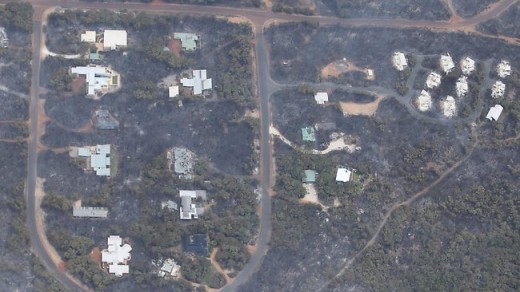
Apparently, the fire started after embers from the still smouldering burn-offs became airborne and ignited in surrounding scrub and began threaten properties along the north-south running Caves Road, west of the township of Margaret River.
7.28pm: Police Commissioner Karl O’Callaghan has told ABC Southwest Radio the current plan was to make sure there were enough resources on the ground for tomorrow.
.
7.40pm: There have been conflicting reports just how many properties have been damaged or destroyed in the fire but according to FESA chief executive Wayne Gregson 21 houses, nine chalets, five sheds and two other buildings had been damaged.
.
7.46pm: The latest alert from FESA advises the potential for severe bushfire behaviour still exists. “The fire has crossed the Margaret River mouth and is currently impacting Prevelly and the south-eastern edge of Gnarabup townsite. “Spot fires have developed in the vicinity of Terry Drive and are burning aggressively in a south easterly direction and have crossed Redgate Road in the vicinity of Redgate Beach. “Winds are moving westerly during the evening, with conditions easing. Homes are still at risk of being damaged by the fire and you need to keep up to date. According to FESA the blaze is likely to have burnt through about 2400 hectares. Firefighters are actively engaged in firefighting at Prevelly, Cherry Road and Burnside Road. Western Power crews are working to re-establish power.
.
8.05pm: While cooler conditions tomorrow are predicted to make it easier for firefighters to control the fire FESA has just issued a severe fire danger advice for parts of the South West land division. A full list of towns and shire in the region can be found at www.fesa.wa.gov.au Residents are urged to stay alert and watch for signs of fire, especially smoke and flames. Have your bushfire survival plan and kit ready.
8.56pm: We are going to wrap up tonight’s coverage now but will be back nice and early in the morning. Visit www.fesa.wa.gov.au for further updates. A Total Fire Ban has been declared tormorrow, Friday, for the shires of Augusta-Margaret River, Busselton, Boyup Brook, Bridgetown-Greenbushes, Donnybrook-Balingup, Manjimup and Nannup.
.
[Source: ‘Parts of Margaret River evacuated as fire approaches‘, by staff reporters, 20111123, ^http://www.margaretrivermail.com.au/news/local/news/general/parts-of-margaret-river-evacuated-as-fire-approaches/2368478.aspx]
.
.
Thu 24th Nov 2011: Flare Up
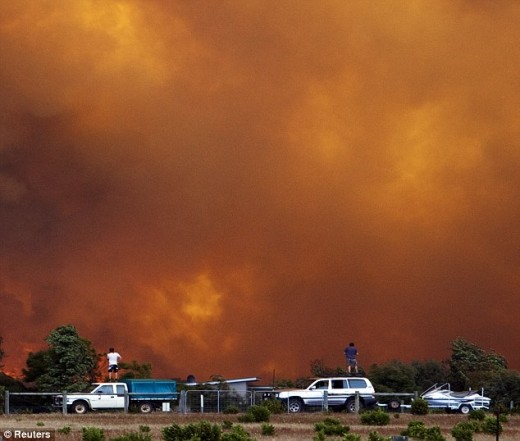
7.05am: Evacuation centre that ”it’s still pretty sleepy”, with dozens of people resting, many of them still uncertain whether they have lost their homes in the fires.
.
7.33am: The Insurance Council of Australia has declared an insurance catastrophe for the bushfires currently burning around Margaret River.
Chief executive Rob Whelan said it was too early to quantify the damage caused by the fires, but expected it to be in the tens of millions of dollars.
.
8.48am: A Bureau of Meteorology spokesman said the temperature at Margaret River was currently 28 degrees, with humidity at 25 per cent.
The spokesman said the winds were currently north north-easterly up to 30km/h with gusts up to 35km/h.
He said that during the day the winds would be about 40km/h with gusts up to 60km/h, changing to north north-westerly through the afternoon.
The Bureau has forecast a maximum temperature of 30 degrees for Margaret River today.
.
9.35am: Wayne Gregson, chief executive at FESA confirms on ABC Radio that so far 10 homes, nine cottages and five sheds have been completely destroyed, and two more homes have been badly damaged.
He said the fire was between 85 and 90 per cent under control, but that this meant that overall it was still out of control.
“Prevelly is under threat. Our focus is on Prevelly in terms of homes and people,” he told ABC Radio.
“At this stage, we think that we have no loss of live or injury.”
He said he had “significant resources” at the scene ahead of blustery winds expected to hit the South-West this afternoon.
.
10.18am: A community meeting is currently underway at the Margaret River Cultural Centre. The crowd is spilling out of the centre as hundreds of people attempt to get the latest information.
DEC incident controller Roger Armstrong is currently addressing the crowd, who are voicing their frustrations at the lack of information. Residents are shouting out for information on road closures and how many homes have been lost.
Mr Armstrong has told the crowd that “we’re not out of the woods here today” and that Prevelly Park was still the main concern for firefighters.
.
10.45am: Prevelly Park remains the area about which authorities are most concerned. DEC incident controller Roger Amstrong said the fire was 80 per cent contained but if winds changed, there was a significant risk for communities west of Margaret River.
.
11.27am: Roger Armstrong, DEC’s incident controller told ABC Radio that an evacuation has been ordered for people in a rural subdivision north of the Margaret River as the bushfire front continues to move.
He said FESA and DEC would be evacuating residents about four to five kilometres ahead of the frontline as the blaze continues to move with the north north-easterly winds.
He said the subdivision, north of Harrington Road, south of Burnside Road, west of Sandpit Road and Boodjidup Roads was the next to be evacuated as a precaution, and said they were in no immediate danger.
Winds in the area are currently about 40km/h, with gusts up to 60km/h.
.
12.38pm: Two more fires have been declared out of control around the state, with six homes in Martin, in the City of Gosnells currently under threat.
The fire is burning between Versteeg Grove and Feldts Road, and residents are being urged to evacuate in the immediate vicinity.
FESA have also warned of a fire that broke containment lines near Denmark.
.
1pm: 140 people find safety in emergency welfare centre ‘Margaret River Cultural Centre on Wallcliffe Road’, intended for Margaret River people who have had to relocate from their homes because of the bushfire, and were being provided with food, care and a place to sleep.
.
1.18pm: The latest update from FESA: A bushfire emergency warning remains in place for people in the Kilcarnup subdivision, Prevelly and Wallcliffe subdivisions and the area north of Wallcliffe Road and east of Caves Road.
An evacuation has occurred in the following areas: south of Burnside Road, north of Harrington Road (also called Exmoor Road), west of Umberto, Kevill, Sandpit and Boodjidup Road.
FESA are advising people in this area that it is too late to leave, and they need to take shelter in their homes and actively defend their properties.
A bushfire watch and act has been issued for people in the greater fire area, including the localities of Ellensbrook, north-east of Kilcarnup, south of Prevelly and east of Caves Road.
.
1.26pm: Mirambeena Aged Care Facility in Margaret River has been evacuated this afternoon.
.
1.32pm: Several reports via Twitter that the fire has now crossed the mouth of the Margaret River. Still awaiting official confirmation but doesn’t sound good. If it’s true, many more homes are likely to be under threat.
.
1.59pm: The fire seems to ramp up as a 100 square-kilometre area south-west of Margaret River is being evacuated, and the blaze is now burning in Prevelly, the DEC told the media scrum.
.
3.00pm: About 30 people stranded on the beach near Prevelly and Gnarabup are being evacuated by jet ski as the fire pushes towards the coast, a resident whose son has been called to help. He said all jet skis in the area had been called to assist.
Only an hour earlier the department had said the beach was the safest place for them to be and that evacuating them would draw resources away from battling the fire. The blaze crossed the Margaret River at Surfers Point Road earlier this afternoon.
.
3.19pm: FESA have advised the Augusta Margaret River Vet Hospital, less than 2 kilometres from the town centre, to now prepare for evacuation. In the last two days they have taken in 31 family pets of people who have been evacuated from the area
.
4pm: WIN news reported flames up to 10-metres high have been spotted as more than 100 firefighters work into the evening to extinguish the blaze.
Ryan Jose told reporters all residents could do was “hope it [the fire] doesn’t burn your house to the ground” while Sam Kinney said residents would be pointing their finger at DEC. “DEC has a lot to answer for” said Mr Kinney.
Residents have told ABC SouthWest radio there is a lot of smoke in the area with one listener saying “it’s very scary”. Another listener has vented her frustration at DEC for burning off on “a day like today” so close to homes.
Olivia who owns some horses has had to take the animals to the local showgrounds and said there is lots of smoke but has yet to see any flames. She was concerned about the change in the wind which may push the fire toward her property.
According to Olivia the townsite was very full with people congregating in the park and in cars as they waited for more information.
More than 100 fire personnel and 30 fire units from the Department of Environment and Conservation, Fire and Rescue Service and local volunteer bushfire brigades are on the scene. Two helicopters and two fixed-wing water bombers are assisting ground crews.
He said almost 100 volunteers were on the scene.
According to DEC the fire is moving in a south-westerly direction towards Ellen Brook homestead at around 200 metres an hour. It is out of control and unpredictable. There have been unconfirmed reports the homestead has been damaged. Firefighters are expecting the wind to change from north-east to north-west about 5pm. This means properties to the east of Caves Road and south of Ellen Brook Road may be impacted by the fire and residents need to keep up to date. So far more than 1000 hectares have been burnt.
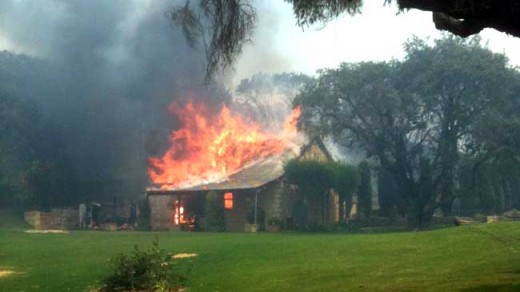 House engulfed near Prevelly 24th November 2011
(likely an ember attack)
House engulfed near Prevelly 24th November 2011
(likely an ember attack)
(Photo by Andre Vanderheyden)
.
[Sources: ‘ Flames up to 10-metres high as residents terrified‘, 20111124, Augusta-Margaret River Mail, ^ http://www.margaretrivermail.com.au/news/local/news/general/flames-up-to-10metres-high-as-residents-terrified/2369987.aspx?storypage=1, ‘WA’s bushfire emergency’, by staff reporters, WA Today, 20111124, 7:59PM, ^http://www.watoday.com.au/wa-news/live-coverage-was-bushfire-emergency-20111124-1nvog.html]
.
.
Fri 25th Nov 2011: Bushfires still uncontained

[Source: ‘Fire threatens Hills home’, by staff reporters, Perth Now, 20111125, ^http://www.perthnow.com.au/news/western-australia/wa-fires-fire-threatens-hills-homes-s-w-resort-at-risk/story-e6frg13u-1226205630864]
.
Key Items:
- A bushfire emergency warning remains in place in WA’s Margaret River region, where 34 homes and holiday cottages have been destroyed by a prescribed burn that got out of control.
- The fires, which have been burning out of control for two days, has claimed 25 homes nine holiday chalets, including historic Wallcliffe House, built in 1865.
- However cooler weather today — and the possibility of some rain — either today or tomorrow is expected to help firefighters.
- Some residents are advised to leave their homes immediately if the way is clear but not to relocate at the last minute.
- The warning is directed at people in the area south of Carters Road, north of Forest Grove Road and Conto Road on the west side of the Bussell Highway, south of the industrial area. If they cannot leave, residents are advised to get ready to take shelter in their home and actively defend it. If they have prepared their property to the highest level and plan to use their home as shelter they are being advised to start patrolling it to put out spot fires.
- Twenty-five houses and nine chalets were lost to the fire on Wednesday and Thursday, and properties have been burnt or damaged at Prevelly, Gnarabup and Redgate, the Department of Environment and Conservation said in a statement early today.
- The Department of Environment and Conservation (DEC) said homes were still at risk and it was important for residents to remain up to date.
- Yesterday the fire crossed the Margaret River mouth and burnt through parts of Prevelly and the southeastern edge of Gnarabup.
- Spot fires in the around Terry Drive resulted in aggressive fire behaviour south of Redgate Road.
- The fire is estimated to have burnt around 2800 hectares.
- According to FESA 27,000 hectares has been burnt since the fire was reported in the area at 10pm on Thursday.
- Thirty Fire and Rescue Service, Bush Fire Service and DEC firefighters from six stations are managing the fire.
- Western power said power had been cut along the Vasse Hwy between Stewart Rd and Seven Day Rd.
- Vasse Hwy has been close between Nannup and Pemberton.
- Late yesterday State Emergency Coordinator Karl O’Callaghan said fires were burning out of control in the several areas including Prevelly, where at least 30 properties have been destroyed and 2000 hectares razed after prescribed burning in the Leeuwin-Naturaliste National Park over the past 10 weeks sparked the widespread blaze on Wednesday.
- He said the State Emergency Management Committee had met on Thursday evening and determined no extra resources would be needed to fight the fires in Margaret River, Nannup and Denmark today. “We spoke about whether there would be more resources required, but we’re not expecting them to need more resources tomorrow,” he said.
- FESA spokesman Allen Gale told 6PR about 30 homes and about 10 sheds were severely damaged. He said the area of concern was Gnarabup and further south towards Redgate, where the fire was headed.
- Fifty-five people stranded on a Prevelly beach overnight had to be rescued by jet ski after the high bushfire swept through their coastal town.
- Reports firefighters were “holding back” a blaze which threatening Margaret’s Beach Resort in Gnarabup.
- Cooler temperatures and low winds are making the bushfire ravaging Margaret River easier to fight, although authorities say the fire is still not contained.
- More than 150 firefighters continue to battle the fire wall, which is 34 kilometres in perimeter.
- About 700 residents have gathered in Margaret River for the latest community briefing from emergency services about the fire.
- Despite confirmation another 15 properties were destroyed overnight, taking the total to 34
- As more than 400 firefighters last night battled an out-of-control blaze in and around Margaret River, 233km south of Perth, Emergency Services Minister Rob Johnson conceded the State Alert fire system failed to send phone warnings to some residents until “after the fire had gone through their particular area”.
- Emergency services across the southern part of the state were stretched to capacity as the south coastal town of Denmark last night braced itself for a similar fire threat. Harvester bans were put in place across the state’s entire wheatbelt region while Perth sweltered in 37C heat, and spot fires across the city’s hills kept locals nervous and firefighters busy.
- The Margaret River fire has so far burnt 2400ha and destroyed or damaged at least 30 homes, including the historic Wallcliffe House, a 1865 riverbank manor restored by Woodside chairman Michael Chaney.
- WA Premier Colin Barnett has acknowledged the burn had “gone wrong”
- A report by the community development and justice standing committee tabled in parliament yesterday found there had not been enough action taken on a recommendation for DEC, the Fire and Emergency Services Authority and local government to develop a single, integrated fuel-load management system.
- A DEC spokesman said the fire was “85 per cent” contained after engulfing1800ha, but if winds pushed the fire south-west this morning, houses in Prevellywere in danger. Extra firefighters would be deployed to secure that front of the fire, he said. “If we can get through the next couple of hours here, things are looking good”, the spokesman said.
- An estimated tens of millions of dollars worth of damage by Margaret River bush fires has been declared an ‘insurance catastrophe’. The Insurance Council of Australia chief executive officer Rob Whelan though it was too early to quantify the damage amount, they predicted it would be tens of millions of dollars.
.
[Sources: ‘ WA Premier admits failures on Margaret River fire‘, by Nicolas Perpitch and Paige Taylor, The Australian, 20111125, ^ http://www.theaustralian.com.au/national-affairs/politics-news/wa-premier-admits-failures-on-margaret-river-fire/story-fn59nqld-1226205457331, ‘ DEC denies Margaret River fire negligence‘, by Courtney Trenwith and Aja Styles, WA Today, 20111124, 12:02 PM, ^ http://fw.farmonline.com.au/news/state/agribusiness-and-general/general/dec-denies-margaret-river-fire-negligence/2369712.aspx], ‘Bush fire is an insurance catastrophe’, Augusta-Margaret River Mail, 20111124, ^ http://www.margaretrivermail.com.au/news/local/news/general/bush-fire-is-an-insurance-catastrophe/2369749.aspx]
.
.
Initial Assessment:
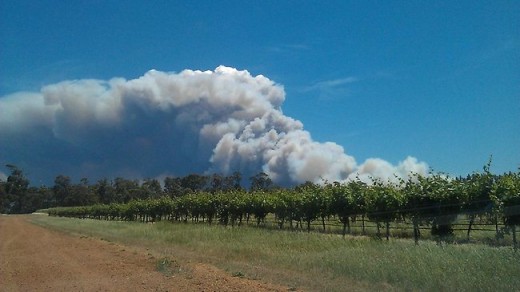
- Sue the arsonist bastards, DEC and the WA Government, jointly in a community-wide class action.
- The ‘blame game‘ phrase is standard defence language of the culpable to try to divert accountability. When someone’s negligence causes your house to burn down, legal justice allows for fair compensation to the victims of negligence. If culpability is proven, compensatory damages are payable by the culpable to restore a victim to the position before the negligence. The fact is not one of discretionary moral blame. It is a fact of culpability. Most criminals will argue black and blue that they are never to blame. They will point to the system, to critics, to the messengers, even to the victims, to anyone but themselves.
- The Premier Colin Barnett has promised a full inquiry into the Department of Environment and Conservation’s handling of the Margaret River fire an hour after the department denied culpability. Barnett’s offer of $3000, to declare Margaret River a disaster area, to spend money on a full enquiry are standard means of government to capture and dissipate community anger so over time all will be forgotten and DEC and FESA business as usual may resume.
- DEC set fire to the environmentally protected Leeuwin-Naturaliste National Park.
- DEC allowed a prescribed burn to get out of control
- Hundreds of people were affected and many have lost everything and will never fully recover – financially, physically, emotionally, as a community
- The full direct and indirect cost of bushfire suppression including the 100 odd firefighters, aircraft and support organisations – must be worn by DEC
- An untold because unknown number of wildlife have suffered and been killed, and perhaps causing or contributing to local extinctions – an independent (DEC-funded) zoological and ecological assessment is called for, with results to be made public.
.
.
Selected Comments from the Community:
‘Well done DEC (Destroy Everything Completely). You have screwed up royally by destroying people’s homes and destroying the environment and the wildlife there. I hope you are proud of what you have done you morons. You knew about the weather conditions and still went ahead. My thoughts go to the people who have lost everything thanks to DEC. My thanks go to the fire fighters who always put in no matter what. They, along with the cops and ambos and the volunteers who will no doubt be there to help everyone, are champs. Stay safe people.’
~ It is I of Perth, posted 20111124
.
‘The time has come to finally get rid of the most incompetent organisation in W.A., the criminal damage they cause to property, humans, wildlife and habitat is beyond comprehension. They create problems where ever they are based to justify their own exsistance.they are also destroying local tourism with their ‘jack boot’ mentality.’
~ the girrawheen oracle, , posted 20111124
.
‘Just having been to Marg River for holidays (the third in 3 yrs to this area) I cannot believe they did a prescribed burn at this time of year in that area I live in Port Lincoln and my house was very close to being burnt down two years ago in our fires .My heart goes out to those people who have lost everything as many of my friends did in our fire .I love the sou west area and stayed at the Margarets beach resort last year hopefully it can be saved as it’s a fantastic resort.Stay safe and stenghth to those who have to pick up the pieces to those who made the decision to burnmshame on you and goodluck sleeping at night as the lives you have shattered are on your consciences. To all those fighting the blaze goodluck and stay safe our prayers are with you……’
~ Mark Wright of Port Lincoln South Australia,, posted 20111124
.
‘My sympathies to the people who have lost homes, need to be relocated and to the animals that were caught in the blaze! Thankyou to the firefighters, ambos and police who will tirelessly work through the days and nights! My fiancé is a police officer. We live in ravensthorpe (2 hrs from esperance) and he has been called to Denmark to help. I hope he stays safe and I am crossing my fingers that nobody will be injured or killed while this fire rages on.’
~ Shouldhavebetterthingstodo of Ravensthorpe,, posted 20111124
‘Firefighters are our heroes but their bosses are twerps.Maybe they will implement the Keelty report recommendations now but then maybe not!’
~ boocuddles, , posted 20111124
.
‘I’m on the surf coast in Victoria and our controlled burns always get out of control! I have family in margs (Margaret River) and friends in prev (Prevelly) so be safe love to everyone helping out. Let’s see the end of these “prescribed burns”‘
~ jodie of victoria, , posted 20111124
.
‘When a cop accidently starts a bushfire with an angle grinder he is charged and prosecuted by police. I wonder if the person/department responsible for this bushfire will also be charged and prosecuted?’
~ Wots good for the Goose, , posted 20111124
.
‘Just the inept DEC (Department of Everything) causing sorrow and mayhem again. There needs to be a full enquiry into all of the DEC doings. They are corrupt, vindictive, horribly inept and almost above the law. Disband the DEC and let’s start again with a fresh honest department.’
~ Dave, posted 20111124
.
‘Let’s see the end of these “Prescribed Burns”. Living in the foothills of Perth, every fine day during the winter months, you see that plume of smoke as CALM lights yet another fire, and in the morning the smoke haze can be seen in the distance, the excuse is to stop wild fires, therefore reduce loss of life and property. People choose to live in wooded areas and know the risks, I was one of them and loved the way of life until I had to come back to live in the burbs, with every hectare CALM burn. How many animals are killed or loose their homes, how many birds nests are burned down during their breeding season in Spring, and how many people with respiratory problems like myself end up sick because of the continuous smoke haze from “prescribed Burning”? Let’s start to do something to stop this legal arson. For goodness sake, doing a so called “prescribed Burn” on a 36 degree day with high winds is stupidity. The person who allowed it should be sacked and sued by the people who lost their homes. Couldn’t agree more!
~ b of a, , posted 20111124
.
‘My family have just lost there house in Prevelly…..’
~ Liz of Jandakot, posted 20111124
.
.
Further Reading:
.
[1] ‘ A Shared Responsibility: The Report of the Perth Hills Bushfire February 2011 Review‘, by Mr Mick Keelty APM AO, ^http://sharedservices.servicenet.wa.gov.au/bushfire/Perth_Hills_Bushfire_Report_Feb_2011.pdf, [ Read Full Report – 8MB]
.
Tags: Caves Road, DEC, Department of Environment and Conservation, escaped burn, Gnarabup, hazard reduction, Keelty Report, Margaret River Bushfire, Margaret River Fire, Master Burn Planning, prescribed burning, Prevelly, State Arson, State-sanctioned Arson, strategic bushfire protection, United Firefighters Union, Western Australian Government
Posted in Threats from Bushfire | 3 Comments »
Add this post to Del.icio.us - Digg
Leave a Reply
You must be logged in to post a comment.
November 23rd, 2011
‘Don’t clear-fell History… let’s have another vision’
[^RechercheBay.org]
… but try telling Forestry Tasmania’s out-of-control logging thugs:
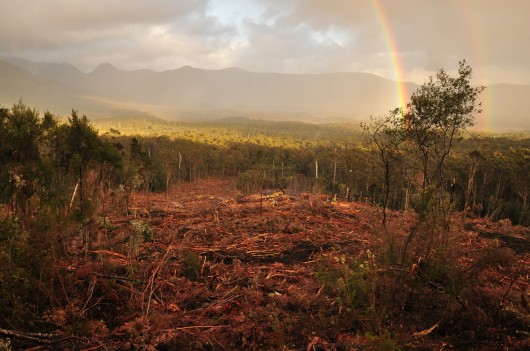
State Slaughter
Tasmania’s precious ancient Southern Forests at Catamaran, today 23rd November 2011
Out of Control State Logger ‘Forestry Tasmania‘ defies the 7th August 2011 moratorium on logging Informal Reserves.
Logging Coupe CM004C (above photo) is a breach of the 2011 Tasmanian Forestry Agreement, Clause 25
[Photo courtesy of Huon Valley Environment Centre ^http://www.huon.org/]
(click above photo image to enlarge, then click again to enlarge again)
.
.
Forestry Tasmania’s supposed ‘Sustainability Charter’:
.
‘The sustainability charter is a forest management plan that reflects FT’s role as stewards of the forest.
The document guides FT’s decision making over the next ten years,
and outlines how our commitment to sustainable forest management
and protection of the environment will be balanced with responsible economic and social outcomes.’
.
[Source: ^http://www.forestrytas.com.au/sfm/sustainability-charter, Read Charter]
.
Ed: What Crap!
.
 The fading farce of forestry’s promise The fading farce of forestry’s promise
.
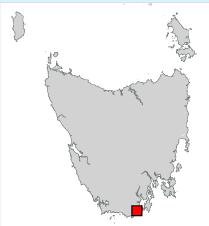 ‘Catamaran Forests’ location in southern Tasmania, near Hobart ‘Catamaran Forests’ location in southern Tasmania, near Hobart
.
 Old map showing relative position of Catamaran Forests (left) of Recherche Bay Old map showing relative position of Catamaran Forests (left) of Recherche Bay
^http://www.recherchebay.org/maps/index.html
.
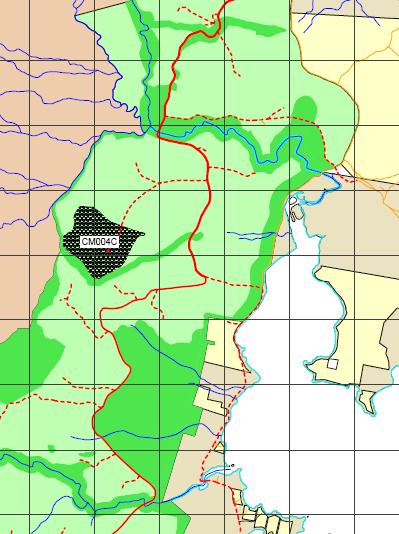 Forestry Tasmania’s map of Coupe CM004C (black area), situated east of Moss Glen
[Source: ^http://www.huon.org/, [Read PDF map] Forestry Tasmania’s map of Coupe CM004C (black area), situated east of Moss Glen
[Source: ^http://www.huon.org/, [Read PDF map]
.
Forestry Tasmania is scheduling provocative new logging in areas that will impact the habitat of vulnerable species like the Tasmanian giant freshwater lobster, Tasmanian devil, Tasmanian wedge-tailed eagle and the spotted-tailed quoll.
And do they have a care factor beyond their pay packet?
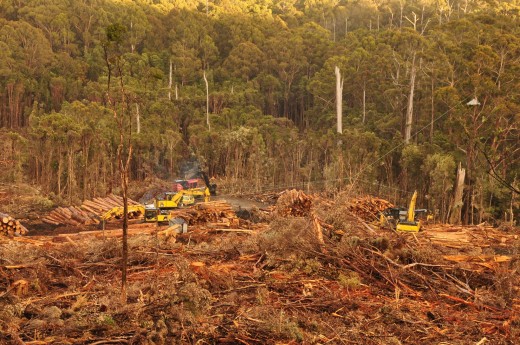 Gotcha Forestry Tasmania! Gotcha Forestry Tasmania!
State Logger ‘Forestry Tasmania’ photographed today logging native forests at Catamaran inside the IGA’s excluded 430, 000ha Informal Reserves.
(Wednesday 23rd November 2011)
Catarmaran forests are IGA Informal Reserves as designated by the Independent Verification Process.
(click above photo image to enlarge, then click again to enlarge again)
.
.
Above is forestry reality, while the following is forestry greenwash…
.
 . .
Forestry Tasmania: ‘Vision’
‘Tasmania’s state forests will be a globally trusted source of sustainable timber and other forest products and services for this and future generations.’
.
Forestry Tasmania: ‘Mission’
‘Forestry Tasmania manages state forests for optimum community benefit, using environmental best practice to create long term wealth and employment for Tasmanians.’
.
Forestry Tasmania: ‘Corporate Objectives’
- To embrace science to achieve best practice environmental stewardship and maintain Australian Forestry Standard certification.
- To create long term business and employment opportunities for the community by managing the forests for multiple use and encouraging down stream processing.
- To achieve positive financial returns through sound, ethical business practice.
- To build community trust through honest dialogue.
.
FT Values:
- We care for people and their environment
- We get things done.
- We do what we say we will do.
- We are proud of who we are and what we do
- We think before we act.
.
Forestry Tasmania has the statutory responsibility for the management of 1.5 million hectares of State forest land. This land contains 39% of the Tasmania’s forests.
About half the forest managed by Forestry Tasmania are available (to us) for ‘sustainable’ timber production (aka clearfell logging, incineration then conversion to plantations – i.e no ecological future).
.
[Source: ^http://www.forestrytas.com.au/about-us ]
.
.
And the forestry reality…‘Forestry Tasmania posts $12 million loss’
[Source: by Patrick Caruana, AAP, 20110829, ^http://www.news.com.au/business/forestry-tasmania-posts-12-million-loss/story-e6frfm1i-1226124330440]
.
‘Forestry Tasmania has posted a $12 million loss, which it says is due to mill closures and the recent inter-governmental agreement on the sector. The state-owned company lost $12.09 million for the 2010-11 financial year, a marginal improvement on the previous year’s loss of $12.26 million. It will not pay a dividend to the Government.
Managing Director Bob Gordon said the closure of timber company Gunns’ mills around the state had hurt the company’s bottom line.
“Effectively, Gunns shut Triabunna, Burnie and the two Bell Bay chip mills at the same time in February-March,” Mr Gordon told reporters in Hobart today.
“In normal circumstances, that would’ve accounted for about two million tonnes a year of our sales, and they disappeared with about two weeks’ notice.”
Mr Gordon said Gunns was Forestry Tasmania’s single biggest debtor.
“We believe that Gunns owes us a bit over $25 million,” he said.
“Of that, about half to two thirds is in dispute. And by dispute, I mean Gunns aren’t paying us. But we believe that we’re on very solid legal, contractual grounds.”
Mr Gordon said the recent intergovernmental forestry agreement, which protects 430,000 hectares of high conservation value forests, was responsible for a substantial writedown in the company’s assets.
“The effect of the proposed extra reservations in the intergovernmental agreement led to writedown of about $100 million in the company’s forestry assets,” he said.
Mr Gordon said the company would now focus its efforts on new rotary veneer technologies, rather than sawlogs and woodchips.
He said Forestry Tasmania would look to open mills around the state capable of creating rotary veneer products in coming years.’
.
.
Bob Gordon’s last statement above…
“Forestry Tasmania would look to open mills around the state capable of creating rotary veneer products in coming years.”
.
Editor:
So if rotary veneer products are Forestry Tasmania’s new timber product strategy using only ‘Tasmanian Regrowth Timbers’, what the hell is FT doing today sending in its logging thugs to eco-rape Tasmanian old growth at Catamaran?
Is there a corporate dysfunctional addiction to ‘old-growth’? Is Old Growth Hate so systemic in FT as to be psychotic and so out of control?
Where is logger patsy Lala?
.
.
In Bob Gordons’ 2008 press release:
.
‘Forestry Growth Plan’
.‘In 2007, the local community celebrated with Malaysian-based company Ta Ann, as its first Tasmanian rotary veneer mill was opened.
When Premier Paul Lennon officially opened Ta Ann Tasmania’s Huon rotary veneer mill in May 2007, it marked the culmination of many years of planning and persistance by FT to attract private sector investment to our State’s wood processsing industry.
FT’s plan in developing the Wood Centre was to provide the foundation for companies such as Ta Ann to invest with confidence in Tasmania. We have now seen the reward of this foresight, with a major project brought to fruition and 60 new jobs created for the people of the Huon Valley.
Projects such as this, which develop innovative, high-quality products from regrowth timbers, will lead the way as the industry gradually makes the transition out of old growth timber.
This growth in jobs is not only good news for the Huon region, it is good news for Tasmania as a whole. Economist Dr Bruce Felmingham has estimated that the State’s economy will grow by some $32 million as a result of this increased employment.
The rotary veneer mill also delivered on Forestry Tasmania’s long-term plan to find new ways of adding value to Tasmanian regrowth timber.
This mill will produce high-quality veneer from regrowth logs that would otherwise be classified as pulpwood. This value-added product will ensure that Tasmania receives the maximum return from its timber.
Already, Ta Ann is receiving a very favourable response to Tasmanian eucalypt veneer through market trials with its Japanese customers. The product is highly regarded in this market for its strength and durability.
In fact, Ta Ann is unable to meet the market demand for this product from the Huon mill alone. We were pleased to see the official start of work in May 2007 on the company’s second veneer mill at the Circular Head Wood Centre.
Tasmania’s ability to supply sustainable wood products has provided Ta Ann with a competitive advantage in its overseas markets.
Ta Ann services major customers, who demand that the timber they purchase is verified as being harvested from sustainable sources.
Tasmania’s reserve system, which surpasses international benchmarks, and Forestry Tasmania’s certification under the Australian Forestry Standard provide this verification.
Forestry Tasmania will continue to develop the Wood Centre to its full potential as an integrated timber processing facility. The Wood Centre will ensure that every piece of timber brought to the site is used to its most valuable end. It will also continue to support the Huon community with investment and employment opportunities.’
Bob Gordon
Managing Director
[Source: Forestry Tasmania website ^http://www.forestrytas.com.au/voices/bob-gordon, accessed 20111123]
.
Ed: And so today Bob’s logging thugs have been caught on camera logging Catamaran old growth.
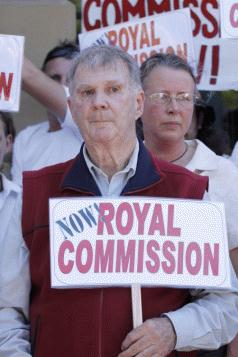 . .
.
Tags: Bob Gordon, Catamaran, Catamaran Forests, Coupe CM004C, Forestry Tasmania, Forestry Tasmania out-of-control, Huon Valley Environment Centre, logger patsy Lala, Recherche Bay, State Slaughtered, Tasmanian Forestry Agreement, Tasmanian Southern Forests
Posted in Tasmania (AU), Threats from Deforestation, Threats from Greenwashing, Threats to Wild Tasmania | No Comments »
Add this post to Del.icio.us - Digg
Leave a Reply
You must be logged in to post a comment.
November 23rd, 2011
‘The axe had never sounded’…
.
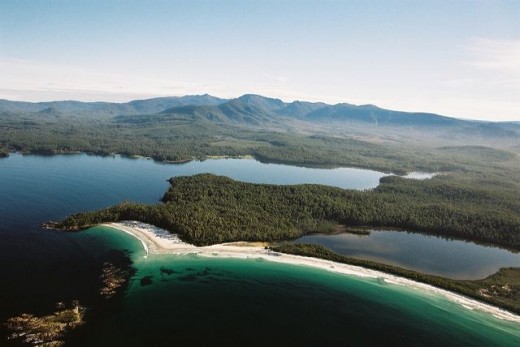 Unprotected ancient native forests around Tasmania’s Recherche Bay Unprotected ancient native forests around Tasmania’s Recherche Bay
(Photo by Bob Brown)
.
Despite Tasmania’s Inter-governmental Agreement (IGA) on 7th August 2011 assuring immediate logging moratorium of native forests in agreed reserves, Forestry Tasmania continues to eco-rape and pillage protected native forests in defiance of this agreement.
IGA Clause 25 states:
‘The State will immediately place the 430,000 hectares of native forest identified in Attachment A (other than any areas that are not State forest), from the 572,000 hectares nominated by ENGOs through the Statement of Principles process, into Informal Reserves. The boundaries of this 430,000 hectares were verified through an independent verification process.’
The southern forests around Recherche Bay were agreed to be included into the Informal Reserves through the Independent Verification Process.
So by embarking on new logging in these Informal Reserves, clearly Forestry Tasmania is in breach of the IGA and operating out of the control of the Tasmanian Government. Forestry Tasmania is logging Tasmania like there’s no tomorrow, because it knows there it has no tomorrow. The business is seriously loss-making. It’s continuing unfettered destruction of Tasmanian native forests is akin to the calculated genocide of Sri Lankan Tamils in May 2009 by the Sinhalese Sri Lankan dictator Mahinda Rajapaksa. Forestry Tasmania’s manic mindset has it logging and woodchipping native forests until they’re all decimated. And Lala’s Labor Government doesn’t have the gumption to enforce the moratorium on its own renegade department.
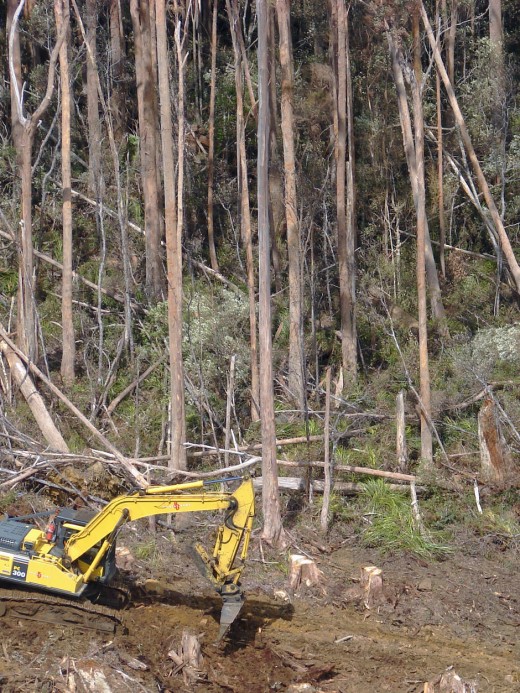 Forestry Tasmania getting stuck into native forests near Tasmania’s Recherche Bay, May 2011
[Source: ABC, ‘Bid for forest peace funding’, 20110519, ^http://www.abc.net.au/news/stories/2011/05/18/3220585.htm?site=hobart] Forestry Tasmania getting stuck into native forests near Tasmania’s Recherche Bay, May 2011
[Source: ABC, ‘Bid for forest peace funding’, 20110519, ^http://www.abc.net.au/news/stories/2011/05/18/3220585.htm?site=hobart]
.
Not only is this organisation out of control, it has no market for its woodchip product. The logs are trucked to woodchipping mills only to be stockpiled with nowhere to go. With no income, it is a business heading for collapse. Unpaid wages will likely remain that way, when the doors are finally closed up. Meanwhile Tasmania’s remaining old growth forests are being logged and the ancient vital ecology decimated.
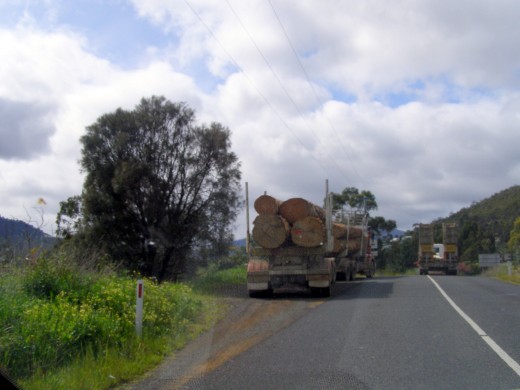 Loaded logging truck (New Norfolk, 20110929)
(Photo by editor, free in public domain) Loaded logging truck (New Norfolk, 20110929)
(Photo by editor, free in public domain)
.
Conservationists are this morning conducting a protest in a logging area in the far south of Tasmania, where world heritage value forests are being clearfelled.
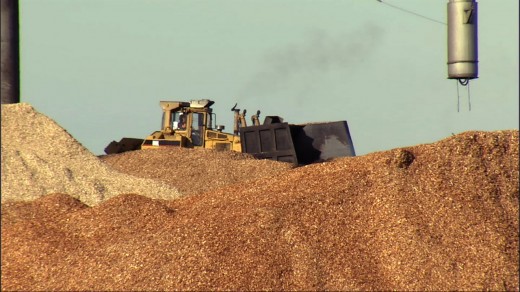
.
Huon Valley Environment Centre’s Jenny Weber says:
‘Tasmania’s world heritage value forests continue to be logged despite yesterday’s controversial announcement that woodchips shipments have been postponed by Tasmania’s only export woodchipping company, Artec (Artec Pty Ltd, Lilydale).’
‘Ta Ann is driving logging in contentious forests, and woodchip logs are leaving these same forests regardless of a viable market for the timber. The Tasmanian taxpayers are subsidising a logging industry that is economically unviable and environmentally unsustainable.’
‘This morning at Catamaran, in threatened forest behind Recherche Bay, a conservationist is in a tree sit, and thirteen people are halting logging. Huon Valley Environment Centre is repeating it’s calls for the immediate end to logging in this forest that borders the Tasmanian Wilderness World Heritage Area, (TWWHA).’
.
Logging in this area, identified by Forestry Tasmania as CM004C, commenced after the Prime Minister Julia Gillard and Premier Lara Giddings announced the Inter-governmental Agreement on 7th August 2011 would provide ‘immediate protection in informal reserves’ for forests such as these.
 Tasmanian Premier Lara Giddings and Australian Prime Minister Julia Gillard
signing the Tasmanian Forests Agreement, 7th August 2011 Tasmanian Premier Lara Giddings and Australian Prime Minister Julia Gillard
signing the Tasmanian Forests Agreement, 7th August 2011
.
Forestry Tasmania Coupe ‘CM004C’ is located within the 572 000ha of identified forests for legislated protection. Last week conservationists participated in a protest in the coupe, and it was revealed that the area is being clearfelled for Ta Ann, export peeler logs and woodchip logs.
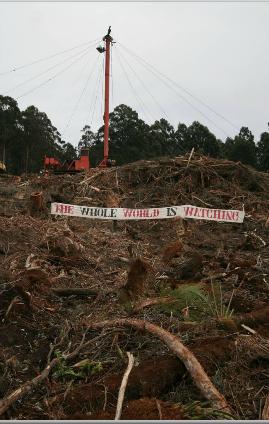 Forestry Tasmania’s cable logging of The Weld Forest, 2009
Tasmanian Southern Forests
(Huon Valley Environment Centre)
(click image to link to slide show) Forestry Tasmania’s cable logging of The Weld Forest, 2009
Tasmanian Southern Forests
(Huon Valley Environment Centre)
(click image to link to slide show)
IGA Clause 26 states:
.
‘The State will ensure that, until the further independent verification process required under Clause 20 is completed, wood supply required under Clause 17 will be sourced from outside the 572,000 hectares of ENGO-nominated High Conservation
Value forest area unless the remaining State Forest area is insufficient to meet the contractually specified quality and quantity of wood supply. Where this is the case, the Tasmanian Government will ensure that wood supplies are sourced outside the 430,000 hectares placed in Informal Reserves. The Tasmanian Government will ensure that the 430,000 hectares of State Forest identified in Attachment A is not accessed’
.
Analysis:
-
There are copious hundreds of hectares of Tasmanian forest area available outside the 572, 000 hectares of ENGO-nominated High Conservation Value forest area.
-
The Lala Labor Government by not ensuring wood supply is sourced outside the 430,000 ha in Informal Reserves is not accessed, and thus in prima facie breach of the IGA. Lala Labor is deliberately and mischievously exercising selective deafness by not listening to ENGO accusations of the breach of the IGA terms. Labor as head wolf of the chicken pen, turning a blind eye to its fellow wolves while they help themselves to the plunder.
-
The Gillard Labor Government is in breach of IGA Clause 27, by failing to act on this trigger ‘to appoint independent expert specifically to review scheduling and other relevant data and attempt to reschedule harvesting activities so as to meet the requirements of contracts and maintain the interim protection of the 430,000 hectares’. The option of log anyway is not an option. The prescribed option under IGA Clause 27, is that the Commonwealth will instead compensate the contract holder for the value of lost profits and unavoidable costs.
-
Both Governments, by sitting on their hands as forests in the Informal Reserves are logged, are in breach of the spirit of the Agreement.
.
.
2009: ‘Woodchip stockpile in Tasmania a ‘health risk’
[Source: Matthew Denholm, Tasmania correspondent, The Australian, 20091014, ^http://www.theaustralian.com.au/news/woodchip-stockpile-in-tasmania-a-health-risk/story-e6frg6ox-1225786465432]
.
The woodchip stockpile in Burnie could pose a “significant health risk”, according to an expert opinion being assessed by health authorities. Tasmanian Director of Public Health Roscoe Taylor said the advice that the stockpile would at times contain Legionella bacteria is being examined.
“I have actually asked someone to have a look at it — we’ll be taking a look at it,” Dr Taylor said.The advice from Legionella expert Trevor Steele concludes the bottom layer of the stockpile on Burnie’s wharf would “undoubtedly” contain Legionella at times. Dr Steele warned the bacteria’s dispersal via dust could pose a significant health risk to townsfolk near the wharf and to workers at the port.
“It (the bottom layer) will at times undoubtedly contain Legionella and these could multiply there given the right conditions,” he said.
“This layer would also act as a source to contaminate newly arrived woodchips, setting the stage for a new cycle of Legionella growth.
“Dispersal of dust … containing these organisms could pose a significant health risk to susceptible persons working in, or residing in, adjacent residential or business districts, as well as to susceptible workers on the Gunns site and in the port area.”
Dr Steele was commissioned to provide the advice by Royal Hobart Hospital physician Frank Nicklason. Last week, Dr Nicklason apologised to timber company Gunns for his 2004 statement that the woodchip pile “almost certainly” had Legionella present that could blow across Burnie. However, he said his concerns about the potential for public health risks from the pile — initially sparked by several Legionella cases in Burnie — remained.
Dr Nicklason said he accepted that Gunns’ sampling in 2002 had not found Legionella in the pile. However, he said Dr Steele’s findings, from July this year, contributed to his concern and warranted further investigation.
Gunns’ own advice, conducted independently in 2002 and released under Freedom of Information, found that the available evidence “suggests strongly” that the bottom layer is “not a reservoir for Legionella”.
However, Dr Steele, formerly director of clinical microbiology at the Institute of Medical and Veterinary Science in Adelaide, disagreed.
“To claim that the sacrificial layer did not contain Legionella on the basis of two tests of small samples is misleading,” he says.
He agreed the bottom layer, because it was relatively undisturbed, was unlikely to pose much risk to the community, but that this did not mean there was no risk, since Legionella there could contaminate new woodchips.
When asked whether Gunns stood by its own findings, a spokesman said: “We don’t have to: Dr Nicklason has stood by it.
“At the time Dr Nicklason gave this apology he was in possession of the Steele report. His attempt to retract his apology by reference to this report is hypocritical, disingenuous and beggars belief.”
Dr Nicklason said his “carefully worded” apology — made as part of settlement of defamation proceedings — merely acknowledged that Legionella had not been found in samples taken by Gunns, and that its report had concluded there was “no available data” to implicate woodchips as a microbial health risk.
There are few detailed studies of Legionella in woodchip piles, although Dr Steele has found the bacteria present in all forms of composting and degrading wood products, including woodchips.
On the basis of his work, Dr Steele believes that conditions in woodchip stockpiles are ideal for Legionella and other micro-organisms that require moisture and warmth.
Legionella is thought to spread by people inhaling the bacteria contained in tiny water droplets, known as aerosols, or in dust.
Over the years, there have been complaints about dust and debris blowing from the stockpile to the Burnie CBD, adjacent to the port.
These have been focused on days of easterly winds, which occur about 20per cent of the time, and when woodchips were being loaded on to ships.
The 2002 Gunns report, conducted by Adelaide environmental health expert Richard Bentham, pointed out that survival of Legionella in aerosols was “highly dependent upon ambient weather conditions”.
For this reason, Dr Bentham concluded the health risks from the Burnie pile were “most probably confined to employees or contractors working on the site” and that transmission beyond the port area was “unlikely”.
However, Dr Steele says Legionella “could survive well in dust travelling long distances, even in adverse climatic conditions”. He cites instances of up to 20km.
.

.
.
Recherche Bay – a brief background
.French explorer D’Entrecasteaux led his ships to grateful shelter in Recherche Bay, southwest of Hobart, in 1792 and 1793, recording “ancient forests, in which the sound of an axe had never been heard”. Barely 200 years later, the forest of Recherche Bay is being threatened by the sound, not merely of axes, but of bulldozers and chainsaws.In spite of public protest and National Heritage listing, the green light to log the area has been given.
- 24/1/06 Entrepreneur/adventurer Dick Smith offers $100,000 towards the purchase of Recherche Bay plus a $1.9 million no-interest loan to be paid back within 12 months.
- 5/11/05 Over 5000 people rally in Hobart for the protection of Recherche Bay. Bob Brown launches a bid to purchase the peninsula, asking people to pledge units of $1,000 to raise the money. Bob pledges $5,000.
- 6/10/05 Senator Ian Campbell announces Recherche Bay will be placed on the National Heritage list but says logging will still go ahead.
- 19/8/05 Launch of Bob Brown’s photographic exhibition and book, Tasmania’s Recherche Bay
- 27/4/05 Actor David Wenham and director Robert Connolly fly over Recherche Bay and visit the tall trees in the Styx Valley, stating their support for conservation.
- 20/4/05 Tasmanian Greens leader Peg Putt calls on French scientists to help save Recherche Bay
- 17/4/05 1000 people rally on site to protect Recherche Bay
- Nov, 03 Tasmanian Heritage Council recommends the protection of the north east peninsula for its cultural significance.
[Source: ^http://www.leatherwoodonline.com/wild/2006/recherche_bay/index.htm]
.
.
1993: ‘Campaign over Recherche Bay scores win’
[Source: Bob Elliston, Hobart, Green Left Weekly, 19931117, ^http://www.greenleft.org.au/node/34677]A five-year campaign to save part of historic Recherche Bay, in south-east Tasmania, has been won, with all parties involved having achieved a satisfactory resolution. The agreement was announced on February 8 by Labor Premier Paul Lennon.Thanks mostly to the support of well-known philanthropist Dick Smith, the tireless negotiations of Greens Senator Bob Brown and the decency of owners David and Robert Vernon, 142 hectares of forest will now be purchased by the Tasmanian Land Conservancy for $2.21 million.Recherche Bay had been under the threat of logging by Gunns Ltd since a contract with the owners was signed in 1998. The bay became home to a French expedition to observe the Earth’s magnetic field in 1792 and 1793. Had logging gone ahead, today’s very destructive logging techniques would have destroyed any chance for useful archaeology of the site to be conducted.Under the deal, Dick Smith will lend the Conservancy group $2 million, $100,000 of which is a personal donation. The state government, which initially supported the Vernon brothers’ decision to have the area logged, has now agreed to assist with $210,000 towards the cost of the land. In addition, the government will waive the $80,000 it would have collected in stamp duty. donations exceeding $238,000 have already been pledged.Although the small forest will not be harvested, no jobs will be lost. More jobs are likely to be generated in services supporting the local community and scientific interest.
However, the deal is not without its critics. Terry Edwards, CEO of the Forestry Industries Association, is distressed that the forest will continue to grow, rather than be turned into cash for Gunns. Newly appointed federal forests minister and Tasmanian senator Eric Abetz has also criticised the agreement, describing it as “a grubby deal”. According to Abetz, the area “has no heritage value”.
.
.
Further Reading:
.
[1] The Last Stand, ^http://www.thelaststand.org.au/, Media Release 20111116:
‘The HVEC and Code Green have taken direct action on Tassie’s forest floor this morning to highlight ongoing logging in high conservation value forests that were supposed to be protected under the Inter-governmental Agreement. Campaigners are currently taking simultaneous action in two logging coupes in the north and south of the island – RS117C on Roses Tier, north of Ben Lomond, and in the Catamaran area, where forests are being logged behind Recherche Bay.
“This is an area that should have been given immediate protection on March 15 this year. Instead we are still seeing machines clearing what has been identified by both the State and Federal Governments as being of high conservation value.” Said Jared Irwin, spokesperson for Code Green.
“The lost values of these forests that are bordering the Tasmanian Wilderness World Heritage Area is such a tragedy, when the logging commenced after the State and Federal Governments announced they would be protected in August 2011,” Said Jenny Weber, Huon Valley Environment Centre’s spokesperson.’
.
[2] ^http://www.nativeforest.net/
.
[3] Tasmanian Intergovernmental Forest Agreement 2011, ^http://australia.gov.au/content/tasmanian-forests-agreement
.
[4] ‘The Axe Had Never Sounded: place, people and heritage of Recherche Bay, Tasmania’, by John Mulvaney, published by ANU E Press and Aboriginal History Incorporated, ANU E Press,
^http://epress.anu.edu.au/aborig_history/axe/html/ch13.html
.
‘A thriving sawmilling industry existed at two centres around the bay by 1900. The steam-driven mill continued at Waterhole Cove until 1868. Then the industry faltered until 1884, when large sawmills were established by the Catamaran River and at Leprena on the western side of the northern bay. By 1900 the population living there exceeded 100 at each centre. It was around the turn of the century that coal mining also offered employment, and an active industrial period followed for a few years. The seams of coal proved limited or uneconomic. As trees were felled, their distance from the sawmill increased. This required timber rail tramways establishing a network radiating out from an area and moved on when that area was harvested. The same applied to transporting coal.
By 1939 a complex network radiated from harbour-based centres at Catamaran, Leprena and Cockle Creek. Traces of these lines survive today in regrowth forests.[1] One moss-covered segment runs by the shore on the north-eastern peninsula in the area of the French activities in 1792.
The timber industry is necessarily situated in forests, so bushfires prove a recurring hazard. The Catamaran mill was destroyed in a 1914 bushfire, coinciding with the abandonment of the coal mine there. The spasmodic and transitory nature of frontier employment was again demonstrated at Recherche Bay when the community of around 100 people, supporting a school and a store, faced sudden unemployment. Today the media feature factory closures and speculate about the future employment of the urban employees. The history of much of rural Australia also has been a boom and bust story of employment, as rural industries prosper then fold. Recherche Bay is a classic example. On a smaller scale than urban plant closures, the impact upon the families dependant upon a timber mill or colliery was no less drastic.’
[Chapter 13. Good and Bad Times]

|
The State will ensure that, until the further independent verification process required under Clause 20 is completed, wood supply required under Clause 17 will be sourced from outside the 572,000 hectares of ENGO-nominated High Conservation Value forest area unless the remaining State Forest area is insufficient to meet the contractually specified quality and quantity of wood supply. Where this is the case, the Tasmanian Government will ensure that wood supplies are sourced outside the 430,000 hectares placed in Informal Reserves. The Tasmanian Government will ensure that the 430,000 hectares of State Forest identified in Attachment A is not accessed. Where harvesting work has already begun in coupes within the nominated 430,000 hectares, rescheduling will occur as soon as practical and a list of coupes that will be harvested will be agreed by the Governments and the signatories, advised by the Independent Verification Group, within two weeks of the signing of this agreement. If sourcing of wood supply from within the 572,000 hectares is considered to be necessary under any circumstances, the Governments will immediately consult with the Reference Group of Signatories and the Independent Verification Group in order to inform them of the basis for sourcing wood supply in those areas, and with the intention of providing this supply in a way that minimises impacts on conservation values.
|
|
During the independent verification process, in the event that Forestry Tasmania reports that it cannot meet contractual requirements from production resources outside the nominated 430,000 hectares, the Governments will undertake the following steps. First, an independent expert will be jointly appointed by the Governments to review scheduling and other relevant data and attempt to reschedule harvesting activities so as to meet the requirements of contracts and maintain the interim protection of the 430,000 hectares. In the event that the independent expert concludes that it is impossible to achieve this through rescheduling on a reasonable commercial basis or through sourcing alternative supplies, the Commonwealth will compensate the contract holder for the value of lost profits and unavoidable costs. Any such costs will be met, in the first instance, from within the $7 million payment in financial year 2011-12 referred to in Clause 35.
|
Tags: Catamaran, Clause 25, Forestry Tasmania, IGA, illegal logging, logging moratorium, Recherche Bay, Roses Tier, Ta Ann Group, Tasmanian Forests Intergovernmental Agreement, Tasmanian Wilderness World Heritage Area, the axe had never sounded, Weld Forest, woodchip horders, woodchip stockpile health risk
Posted in Tasmania (AU), Threats from Deforestation, Threats to Wild Tasmania | No Comments »
Add this post to Del.icio.us - Digg
Leave a Reply
You must be logged in to post a comment.
November 18th, 2011
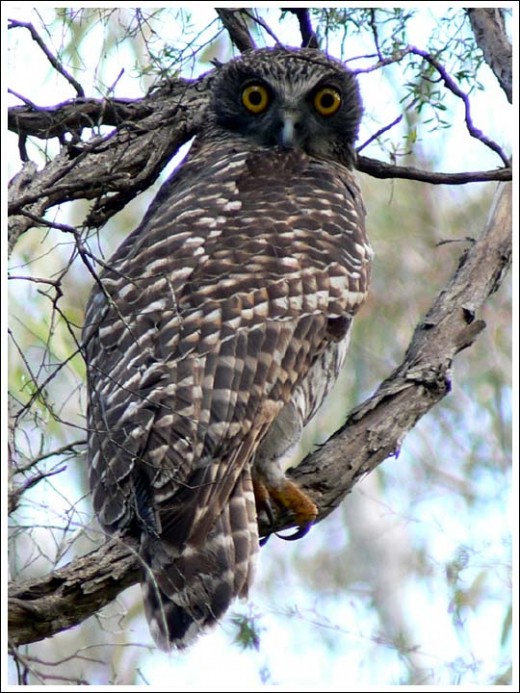 Powerful Owl (Ninox strenua)
(© Photo by Duncan Fraser, ^http://bencruachan.org/blog/?p=170) Powerful Owl (Ninox strenua)
(© Photo by Duncan Fraser, ^http://bencruachan.org/blog/?p=170)
.
The Powerful Owl (Ninox strenua) is Australia’s largest owl, yet in Victoria it has become a threatened species due to human destruction of old growth forest habitat; particularly the destruction of hollow-bearing trees used by this owl for nesting, roosting and home for its natural prey – possums. ‘Powerful Owls are adversely affected by the clearfelling of forests and the consequent conversion of those forests into open landscapes, but the species may persist in forests that have been lightly or selectively logged.’
[Source: ^http://www.birdsaustralia.com.au/our-projects/powerful-owl-wbc.html]
.
Since European settlement, 65% of Victoria’s forest cover has been cleared (Woodgate & Black 1988). Only 5% of freehold land remains forested. This past permanent loss of habitat has likely led to an overall reduction in owl numbers and fragmentation of the original continuous population into a series of small residual populations, each of which is at risk of becoming locally extinct.

‘It is estimated that hollows suitable for owls do not form, even in the fastest-growing eucalypts, until they are at least 150-200 years of age (Parnaby 1995). Of 21 nest trees observed by McNabb (1996) in southern Victoria, about 50% were senescent and all ranged between 350-500 years of age, based on data collected by Ambrose (1982).
Over much of its range, the lack of suitably large hollows is considered to be a limiting factor to successful breeding and population recruitment. The Powerful Owl is, therefore, vulnerable to land management practices that reduce the availability of these tree hollows now or in the future. The loss of hollow-bearing trees has been listed as a potentially threatening process under the Flora and Fauna Guarantee Act (SAC 1991).
In addition, prey density may be an important determinant in territory size and breeding success, particularly considering that only the male hunts during the breeding season. Seebeck (1976) estimated that about 250 possums (or their equivalent) would be required per year by a family group and recent studies have estimated around 300 prey items for a breeding pair rearing two young (Webster unpubl. data.). Key prey are also dependent on hollow trees.’
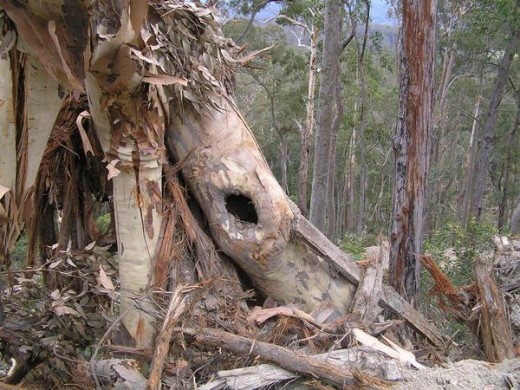
In its final recommendation the Scientific Advisory Committee (SAC 1994) has determined that:
‘the Powerful Owl is significantly prone to future threats which are likely to result in extinction, and very rare in terms of abundance or distribution.’
.
The short-term conservation objective is to prevent further decline by ensuring that good quality habitat for at least a population target of 500 breeding pairs of Powerful Owl is maintained on public land in Victoria.
[Source: ‘Powerful Owl Action Statement‘, Victorian Government’ s Department of Natural Resources and Environment (or whatever its latest incarnation is), ^http://www.oren.org.au/issues/endspp/powerfulowlAS.htm]
.
.
‘Impact of Bushfire on Sooty Owls and Powerful Owls’
[Source: Rohan Bilney, Report on Sooty Owls and Powerful Owls for the Supreme Court proceeding number 8547 of 2009 – Environment East Gippsland v VicForests, pp.12-13]

Greater Sooty Owl (Tyto tenebricosa)
.
‘Fire is likely to kill individual owls and small mammals, and remove potential habitat in the short-term, potentially resulting in long-term impacts.
‘How owl populations adapt or respond to fire is largely unknown’
.
‘Fire can consume hollow-bearing trees, while also stimulating hollow formation, but as hollow formation can take decades, frequent fires are likely to result in a net loss of hollow-bearing trees from the landscape (Gibbons and Lindenmayer 2002). This is likely to cause detrimental effects to all hollow-dependant fauna (Catling 1991; Gibbons and Lindenmayer 2002; Garnett et al. 2003).

‘Sooty Owls typically occupy habitats subject to infrequent fire regimes such as wetter forest types, possibly due to higher densities of hollow-bearing trees in such landscapes. Frequent fire regimes also simplify habitat structure, which can cause deleterious impacts on terrestrial mammals (Catling 1991; SAC 2001), which includes increased predation rates by feral predators due to the loss of habitat refuge (Wilson and Friend 1999). Overall, it therefore seems likely that owls and small mammals will be negatively impacted by frequent fire regimes. It is likely, however, that it will be the impacts of fire on prey densities that dictate how the owls respond to fire.
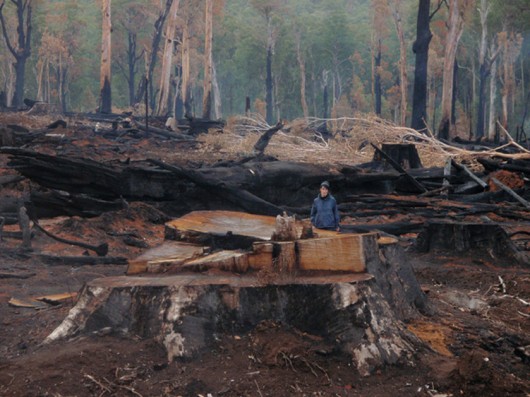 Brown Mountain ancient old growth logged, incinerated, razed by VicForests
(Photo by Environment East Gippsland) Brown Mountain ancient old growth logged, incinerated, razed by VicForests
(Photo by Environment East Gippsland)
.
‘Most species are not adapted to fire per se, but adapted to a particular fire regime, which include fire aspects such as intensity, frequency, seasonality and scale (Bradstock et al. 2002). Due to variations in the life history requirements of species and their ability to survive fire, particular fire regimes can advantage some species, while being deleterious to others (Bradstock et al. 2002; Gill and Catling 2002; Keith et al. 2002). Due to the varying ecological responses to fire, it is important for biodiversity conservation that we not only understand species responses to particular fire regimes, but to ensure that appropriate fire regimes are maintained across the landscape. As prescribed fire is used as a management tool for reducing fuel load to minimise fire risk, it is important that its effects on biodiversity are well understood.
‘Unfortunately, knowledge on how native species respond to particular fire regimes is poorly understood, especially for fauna (SAC 2001, 2003; Clarke 2008). So, in the absence of this crucial ecological information it is virtually impossible to implement appropriate fire regimes which will result in minimal negative ecological impacts, let alone enhance biodiversity. Fire, both prescribed burning and wildfire, can present a threat to owls if conducted at inappropriate seasons, frequency, intensity or scales. It is therefore difficult to quantify the threat. The threat of inappropriate burning at high fire frequencies is likely to be mainly concentrated around human assets and populations, while fires in more remote forested areas will be subject to less frequent fires (DSE 2004). Fire also affects the entire owl population because all habitats occupied by owls is flammable.
‘Victoria has experienced three catastrophic fire events in the past 7 years, and combined with prescribed burning, approximately three million hectares have been burnt in this time.‘
‘This equates to approximately 2/3 of potential Sooty Owl habitat in Victoria. How populations of Sooty Owls and many other forest dependant fauna have been affected by these fires remains poorly understood or unknown. The ability for forest fauna to recover is therefore being hampered by further prescribed burning, and recovery is also hampered by reduced fecundity caused by a decade of drought, and for the owls, low prey population densities.’
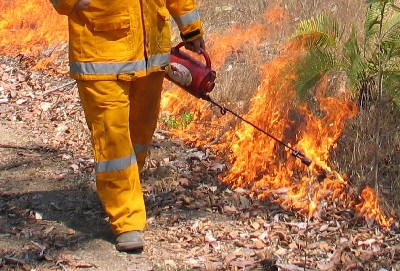
.
.
The ‘Bushfire Fighting Principle’ corrupted by blinkered economic rationalism
.
The traditional principle of bushfire management is to put out bushfires…one would think. Yet this simple concept has been hijacked, bastardised and corrupted by successive governments as a consequence of systemic under-resourcing. Government under-resourcing has contributed to the deadly human toll in recent years.
The corrupting of this core bushfire management principle has morphed into a blanket one-size-fits-all defeatist policy of broadscale prescribed burning – burning the bush before it burns. The bushfire management tradition of ‘suppression‘ has been economically rationalised and politically supplanted by the proactively sounding notion of ‘prevention‘.
In Victoria, the fundamental job of putting out bushfires has bureaucratically morphed into a ‘Code of Practice for Fire Management on Public Land’, with its two general principles…
.Fire management planning on public land must address the threat of wildfire, guide the use of prescribed burning, and provide for the achievement of integrated land management objectives such as human safety and environmental management.’ (Clause 50)
‘Fire management activities must be undertaken in a participative manner where the responsibility for reducing the likelihood and consequence of wildfire is appropriately shared between public and private land holders and managers.’ (Clause 51)
.
What happened to the fundamental principle of bush fire fighting?
To put out bushfires!
Instead, vast areas of remaining native bushland and forests across Australia are being deliberately burnt to the point where critical faunal habitat is sterilised – only the trees remain, while the rich underlying vegetation, demonised as ‘hazardous fuel‘ is incinerated and repeatedly prevented from regrowth. Wildlife habitat has become a fuel hazard targeted for burning by the very custodians charged with wildlife conservation. And out of the Victorian Royal Commission into the Black Saturday bushfires, the anticipated kneejerk response by bushfire agencies to commence Prescribed Burning Armageddon against the bush has started as many genuine conservationists have feared.
And what has been the full realised cost of the 2009 Victorian Bushfires – valuing human lives, human injuries, ongoing trauma, livelihoods, wildlives, livestock, private property, natural assets, on top of the direct operational response cost, the indirect costs of contribiting agencies, the donations raised, capital costs, the opportunity costs, the investigation costs, the Royal Commission costs? No one has come up with a figure. These values were outside the Victorian Royal Commission’s terms of reference – so what real value was it? Economic rationalising of emergency management is costing lives and contributing to species extinctions.
.
.
Victorian Government Policy of Bushfire Lighting
.
The Victorian Government’s delegated custodian on natural areas across the State is the infamous Department of Sustainability and Environment (DSE), with a reputation for lighting most of the bushfires it euphemistically labels as ‘prescribed burning’ wherein it finds unburnt bushland and prescribes its own burning regimes. When such custodial agencies restore the word ‘conservation‘ back into their title, some respect may return.
DSE’s ‘Code of Practice for Fire Management on Public Land‘ was revised in 2006. It relies upon background premises that since “much of the Australian continent is fire-prone”, that “fire occurs naturally”, that “many species of vegetation and wildlife have adapted to living within the natural fire regime” and that “Victoria’s Indigenous people used fire as a land management tool for thousands of years”. The Code justifies that “Victoria’s flora, fauna and the ecosystems they form are adapted to fire of varying frequencies, intensities and seasonality.” Victoria’s Flora and Fauna Guarantee Act 1988 has objectives to ensure “Victoria’s native flora and fauna can survive, flourish, and retain their potential for evolutionary development”. Now the integrity of this Act is under threat. Perversely DSE’s Code of Practice argues that deliberate burning of bushland and forest habitat will help Victoria’s native flora and fauna to survive, flourish, and retain their potential for evolutionary development.
Crap!
DSE stretches its rationalising propaganda further, claiming that excluding bushfire can have “negative consequences for Victoria’s flora and fauna“. And this is where the hijacking, bastardisation and corrupting turns from mythology into unsubstantiated falsehood and misinformation. No document exists to zoologically prove that native fauna will suffer such negative consequences if it does not have a bushfire range through its habitat. As a result, the Code of Practice implies that bushfire is ok for all Victorian bushland and forests – DSE conveniently convinces itself that the urgent moral imperative for DSE to suppress bushfires is extinguished. So now it lights more fires than it puts out.
The Code also premises that “often these wildfires can be difficult to suppress”. Well no wonder with an grossly under-resourced, firetruck-centric volunteer force.
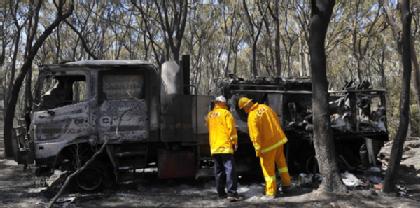 . .
.
‘DSE holds fire management workshop in Bendigo’
.
On 22nd June 2011, DSE staged a workshop of stakeholders to discuss some recommendations of the Royal Commission into Victoria’s February 20o9 bushfire tragedy. According to the website ‘Friends of Box-Ironbark Forests’, in attendance were representatives from the CFA, local government, The Wilderness Society, Bendigo Field Naturalists Club, Friends of Kalimna Park, North Central Victoria Combined Environment Groups [NCVCEG], Apiarists Association and DSE attended a workshop on June 10 to learn about the process for implementing the findings of the Victorian Bushfires Royal Commission. Though Friends of Box-Ironbark Forests (FOBIF) was not invited to this workshop, we were represented by members of some of the other groups.
Once again DSE’s Code of Practice for Fire Management on Public Land (COP) is to again be reviewed and updated, except its premises have not changed, so what’s the point? The following notes taken on the issue of Fire management Zones/Prescriptions is telling of how disconnected DSE is from wildlife habitat conservation:
.
‘Fire Management Zones (FMZ) have been reviewed recently. An interim zoning is to be released soon. With little time left the group briefly discussed the merits of fire management zones, and how they might relate to the risk model. It was highlighted that the residual fuel load is an important aspect, but further detail as to how was not provided.
NCVCEG made the point that the current diagram used by DSE to represent the relationship between ecological outcomes and fire management outcomes across the four FMZ is misleading, encourages poor planning, discourages biodiversity management in zones 1 and 2, and neglects to recognise that fire management outcomes may be achieved in all zones, especially where integrated planning and alternative practices (to prescribed burning) are established.
In relation to FMZ the Apiarists pointed out that Box Ironbark forests generally have very low fuel levels in comparison to heavily forested regions where many lives were lost during the fires in 2009. The merit of burning areas used for honey production was questioned and the long term impacts of severe burning on Box Ironbark forest ecology was raised.’
.
[Source: Friends of Box-Ironbark Forests, 20110622, ^http://www.fobif.org.au/2011/06/dse-holds-fire-management-workshop-in-bendigo/]
.
.
Yet at the same time DSE points out that… ‘biodiversity is in decline‘
.
In its ‘Victoria’s Biodiversity Strategy 2010–2015: Consultation Draft‘ DSE reminds us that two hundred years of (immigrant deforestation), severe droughts, major bushfires and the impact of climate change, has severely affected Victoria’s species and ecosystems. DSE professes:
- Victoria is the most cleared and densely populated state in Australia. Victoria has the highest proportion (48%) of sub-bioregions in Australia in poor condition, with four out of Australia’s five most cleared bioregions found in western Victoria (CES 2008).
- Approximately half of Victoria’s native vegetation has been cleared for agricultural and urban development, including 80% of the original cover on private land. Victoria is losing native vegetation at a rate of some 4,000 hectares per year, mostly from endangered grasslands (DSE 2008).
- Victorian landscapes are the most stressed in the country (NLWRA 2001). One third of Victoria’s major streams are in poor or very poor condition. Two thirds of wetlands have been either lost or degraded and nearly half of our major estuaries are significantly modified. Flows at the Murray mouth are estimated to be a quarter of what would naturally occur (VCMC 2007).
- 44% of our native plants and more than 30% of our animals are either extinct or threatened (CSIRO 2004). The highest number of threatened species in any one region in Australia occurs in north western Victoria.
- Exotic species represent about 30% of the Victorian flora with 1,282 species considered naturalised and a further 214 species considered incipiently naturalised in Victoria. This has increased from 878 naturalised species in 1984. It is estimated that an average of 7.3 new plant species establish in Victoria per year, and this number is increasing by a rate of 0.25 plants per year. Approximately 90% of the native vegetation in Melbourne is impacted by weeds, with more than 50% considered severely degraded. There are 584 serious or potentially serious environmental weeds in Victoria with 129 very serious (CES 2008).
- Over 100 marine species have been introduced to Port Phillip Bay.’
.
[Source: Victorian Government’s Department of Sustainability and Environment, ^http://www.dse.vic.gov.au/conservation-and-environment/biodiversity/victorias-biodiversity-strategy/biodiversity-strategy-renewal/draft-victorian-biodiversity-strategy-2010-2015/current-state, Clause 2.2 ‘Biodiversity is in decline‘]
.
.
State aware but doesn’t care
.
The Victorian landscape has undergone massive changes in the past 150 years. As a consequence of environmental degredation and destruction of indigenous flora and fauna:
- Over 60% of the state has been cleared, and much of what is left is seriously degraded by weed invasion;
- Of the two thirds of the state which is privately owned, only 5% retains its natural cover;
- Soil erosion and salination have become serious problems;
- Over 35% of our wetlands have been drained;
- Close to 80% of rivers and wetlands have been substantially modified;
- Almost all native grasslands have been eliminated or modified;
- Many other vegetation communities are almost extinct, or critically endangered;
- Over 900 exotic plant species have been established in Victoria, many of which are weeds, and scores of noxious exotic animal species are now widespread;
- 23 native mammal species have become extinct in Victoria.
.
[Source: The Southern Peninsula Indigenous Flora & Fauna Association Inc., ^ http://www.spiffa.org/victorias-biodiversity-crisis.html]
.
And the Victorian Government is well aware.
DSE acknowledges that the ‘clearing of native vegetation (across Victoria) and habitat has also led to the loss or decline in wildlife species. Habitat fragmentation has meant that wildlife are more at risk from predators, harsh environmental conditions, and human influences (e.g. roads) as they move between remnant patches. Isolated patches support fewer and lower densities of wildlife, increasing the chances of population extinction in individual patches as a result of the impacts of chance events upon genetically simplified populations. Habitat loss and degradation also increases the susceptibility of wildlife to severe environmental conditions, such as fire and drought, and broader processes, such as climate change and changing rainfall patterns.’
DSE acknowledges that ‘while maintaining or restoring ecosystem function will help to reduce the rate at which species decline, we already have a legacy of species that are at risk due to past ecological disruption, and a latent ‘extinction debt’. Victoria’s past land management actions have resulted in the loss of species and created and ongoing risk of future losses. Many existing threatened species occur in remnant or fragmented landscapes where the work required to recover them is intensive, expensive and long-term. In extreme cases it is necessary to remove part of the remnant population to captivity until critical threats have been mitigated.
DSE acknowledges that ‘effective threatened species recovery requires:
- Effectively dealing with threats to reduce the rate at which species become threatened;
- Conducting recovery efforts in situ by managing the processes that degrade their habitat or directly threaten them, including, where required, support from ex situ conservation programs;
- The best available knowledge and an adaptive management approach, including adoption of the precautionary principle when required;
- Co-operative approaches to recovery, with an effective and efficient mix of incentives and regulations; and
- Planning and regulatory frameworks to provide clear and consistent policy, process and outcomes.’
.
Yet in the same breath DSE goes on to reinforce its ‘fire is good for wildlife‘ propaganda – ‘a substantial proportion of Australia’s unique biota is dependent, to varying degrees, on fire and the variety of fire regimes for its continued existence and development.‘
[Source: DSE’s ‘Code of Practice for Fire Management on Public Land‘, Clause 2.3.8 ‘Challenges relating to fire management’]
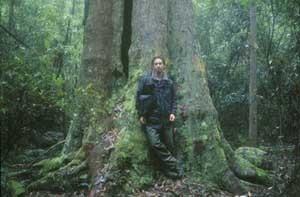
.
.
‘Fuel reduction burns threaten species’ – or Black Saturday incompetence an excuse for broadscale State Arson
[Source: Peter Vaughan, Monash University, Melbourne, 20100531,^http://www.reportage-enviro.com/2010/05/fuel-reduction-burns-threaten-endangered-species/]
.
‘Conservationists are concerned that fuel reduction burns in East Gippsland will threaten endangered species and reduce biodiversity.
On March 16, fire managers from the Department of Sustainability and Environment (DSE) ignited a fuel reduction burn in the Dinner Creek catchment of Waygara state forest, approximately 14 km West of Orbost. The fire quickly gained intensity, aided by a temperature of 30 degrees Celsius. It burnt most of the environmentally sensitive vegetation within the fire zone along four kilometres of the Dinner Creek.
DSE Fire Manager for the Orbost Region, Steve de Voogd, said that the Dinner Creek fuel reduction burn grew hotter than intended. The fire was meant to burn 2206 hectare of coastal forest and leave a mosaic of burnt and un-burnt areas within the fire’s containment lines.
.
According to Mr de Voogd, the DSE is now under community pressure to reduce the risk of wildfire through fuel reduction burning, and that must take precedent over ecological considerations.
.
“Although there is probably room for more fire ecology planning, it is incumbent on the DSE to take action because the consequences of doing nothing may be worse,” Mr de Voogd said.
Most of the hollow bearing trees in the burn zone, which were home to a number of endangered species protected under state and federal law, were destroyed.
Dr Rohan Bilney, an expert on Australian forest owls and spokesperson for the Gippsland Environment Group, said that the program intended to burn large areas of coastal forest without adequate ecological planning, monitoring or research, which threatened crucial habitat and food sources for the forest’s owls species.
.
“The coastal forests of East Gippsland are the strong hold of the Masked Owl, a species listed as threatened under two laws: the Victorian Flora and Fauna Guarantee Act and the Federal Environmental Protection and Biodiversity Conservation Act. Most of East Gippsland’s Masked Owls live in the coastal forests now being subjected to intense broad area fuel reduction burns by the DSE,” said Dr Bilney.

Masked Owl (Tyto novaehollandiae)
.
The Masked Owl Action Statement, prepared under the Victorian Flora and Fauna Guarantee Act, estimates only 150 pairs of Masked Owl exist in Victoria. Of that total, 100 pairs are found in East Gippsland and most are concentrated in the coastal forest.
DSE Manager of Biodiversity in East Gippsland, Dr Steve Henry, said that the current DSE fuel reduction fire strategy allows for large fires but burning on such a scale leaves few options for the protection of important ecological values.
“If there are some areas that contain specific environmental attributes that we want to protect, we could exclude them from fire with a bulldozer line. However that is expensive and often very destructive on most of these large burns. The main management technique used is the way in which the lighting pattern of the fire is done, sometimes that is not as effective as we would hope,” he said.
Mr Henry said that funding constraints have not permitted the DSE to conduct detailed ecological studies of the coastal forests, including the effect of fire on the environment.
A post-fire ecological survey is currently being conducted by the DSE in selected fuel reduction areas.
The Dinner Creek fire was just one of 48 fuel reduction burns planned by the DSE for the region during 2009-2010. Like other fuel reduction burns, the DSE must comply with the Victorian Code of Practice for Fire Management on Public Land.
The primary objective of the Code is to protect of life and property, while minimising negative impacts on natural and cultural values, and abiding by threatened species legislation, are also included.
The Code of Practice also states that the DSE must prepare a Fire Ecology Strategy that includes input from ecological experts and full consideration of all available scientific research.
If little ecological research exists, fuel reduction burning can be conducted under the rational that it may reduce the future risk of wildfire.
.
In the absence of scientific data, the DSE will continue to plan fuel reduction burns from computer desktops, utilising the ad hoc data collected as part of the Environmental Vegetation Class mapping projects of the late 1990s.
While political pressure continues to increase, the DSE fire policy will remain focused on protecting the community against the spectre of Black Saturday.’
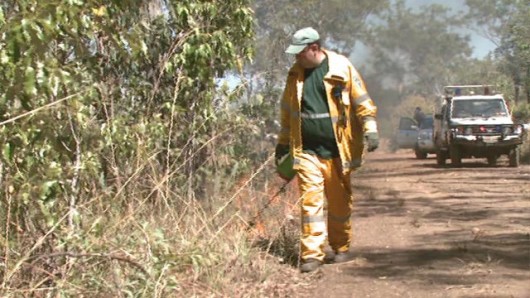 Burn it in case it burns, because we don’t have the resources for wildfire suppression Burn it in case it burns, because we don’t have the resources for wildfire suppression
.
.
‘Climate change, fires and logging -the deadly combination for Victoria’s species’
[Source: Environment East Gippsland, ^http://www.eastgippsland.net.au/?q=node/446]
.
‘Two hundred years ago the Sooty owl was abundant and fed on about 18 species of ground prey in Gippsland. Today they have only two or three to chose from. Other species are under similar pressure.
Many of our native animals have become sparser in numbers and their range has shrunk. Some, like the Southern Brown Bandicoot (Federally listed but not State listed), are now isolated in small “island” populations which are dangerously close to extinction mainly due to threats of fire and predation. Fires destroy understorey cover, making it easy for foxes and dogs to wipe out small populations of ground dwelling animals.
The 2003 fires and the recent December ’06 fires have destroyed the habitat and ground cover over about 2 million hectares of Victoria’s forested country. This has had a horrifying impact on ground mammals, birds and hollow dependent species.
.
Scientist and Quoll expert, Dr Chris Belcher, has calculated that this species’ Victorian numbers were reduced by 33 – 45% as a result of the ’03 fires. The December ’06 fires would have reduced this again to even more precarious numbers.
The isolated colony of Long Footed Potoroos discovered around Wonangatta (or Wongongara?) will most likely have been killed as a result of the recent fires.
The Helmeted Honeyeaters had five small and isolated populations left but the 1983 fires wiped out four of them. Yellingbo is still likely to burn and our faunal emblem will be extinct on this planet.
Bandicoots are very fire sensitive. There are small and vulnerable populations scattered in Gippsland. In 1994, fires burnt 97% of the Royal National Park and Bandicoots no longer survive in this area. The safety of thick ground cover does not return for years, meaning foxes and dogs heavily predate any survivors.
.
East Gippsland is the last stronghold for many of our rare and endangered fauna. It is a wetter environment and has much higher floristic diversity and therefore animals.
Climate change will now make fires more frequent and intense in SE Australia (CSIRO). Governments must adapt management of natural areas to account for this reality as it is for agriculture, water and energy.
The greatest pressure on Eastern Victorian species has been in the Critical Weight Range from 35 gms to 5 kg. Many ground dwelling animals are extremely susceptible to fire. Potoroos, Quolls, Bandicoots, native rodents (the rare New Holland Mouse, Smokey Mouse etc).
The predation rate after a fire is huge and patches of unburnt forest within the fire zones are absolutely essential to help populations survive predation, recover and disperse in time. These areas are critical to protect from further disturbance.
The recovery of species after a fire is now very different from 200 yrs ago. Populations are more isolated, salvage logging further destroys their chances, there is less diversity of prey species for the higher order predators like owls and quolls to turn to if gliders and possums are impacted by fires (or logging the hollow-rich forests).
Logging ecologically diverse forests favours the return of biologically poor tree communities such as silvertop and stringybark. The forests with mixed gum and box throughout can have 20-50 times higher animal densities. Significant vegetation changes due to massive landscape disturbance such as clearfelling, makes endangered species recovery from fire even more unlikely.
In the 1990s, East Gippsland supported seven times more threatened species than other areas in Victoria. This made the region seven times more important for our endangered species’ survival. Since the fires of 03 and 06, it is not unreasonable to suggest that East Gippsland is the last refuge and last chance for these species to survive extinction. Extinction can happen very quickly.
Species which are fairly general in their roosting, nesting and feeding needs can often survive (as they have in other areas of the state) but the many specialist species which rely on large areas of diverse and thick forest are highly likely to vanish forever.
This is why the hasty and unscientifically mapped areas of newly reserved forest require careful refinements. The needs of the state’s threatened species must be made the priority. Independent biologists and on-ground local knowledge (not VicForests) must be used to finalise the new reserve boundaries, with the long-term impact of the recent fires as a major guiding factor.
The Bracks Government suggested there be no net loss of resource as an adjunct to the mapped reserve areas. This is an impossible and irrational qualification as fires can take out large percent of the forest and therefore wood resources in one season. Commercial use of forest should be allocated only after biologically essential considerations have been adequately addressed.
Another point made in pre-election promises was to make sure the new areas are mapped and industry changes are resourced so as to adhere to the terms and spirit of the RFA. This then should see the government honour its long overdue commitment to carry out research into the impact of clearfelling on threatened species, to identify sustainability indicators, carry out five yearly reviews and ensure threatened species are protected. None have been honoured in the last 10 years!
The recent court ruling regarding the EPBC Act should also give the state government substantial opportunity to begin to alter protection measures for Federally listed species in East Gippsland.
The conscience of this government cannot put the very limited future of several sawmills ahead of a large number of entire species. Continued logging of intact original forests must not be the overriding priority. The ability for species to cope with the escalating impacts of climate change and fires from 2007 onwards has to now be put ahead of politics and union threats. These species survived well in Australia for over 40,000 years. The clearfell logging industry has been around for less than 40 years. Political priorities have an even shorter lifespan.’

.
.
Further Reading:
.
[1] ^ http://eastgippsland.net.au/files/Sooty_Owl_%20Powerful_Owl_Bilney_December_2009.pdf , [ Read Report]
[2] Environment East Gippsland website, ^ http://www.eastgippsland.net.au/
[3] ‘ Sooty Owl Action Statement‘, Victorian Department of Sustainability and Environment (DSE), [ Read Statement]
[4] ‘ Powerful Owl Action Statement‘, (DSE) ^ http://www.dse.vic.gov.au/__data/assets/pdf_file/0019/103177/092_powerful_owl_1999.pdf , [ Read Statement]
[5] ‘ Masked Owl Action Statement‘, (DSE), ^ http://www.dse.vic.gov.au/__data/assets/pdf_file/0015/103173/124_Masked_Owl_2001.pdf , [Read Statement]
[6] Victorian Rainforest Network website, ^ http://www.vicrainforest.org/
[7] The Southern Peninsula Indigenous Flora & Fauna Association Inc., ^ http://www.spiffa.org/victorias-biodiversity-crisis.html
[8] ‘Protecting Victoria’s Powerful Owls’, ^ http://www.dse.vic.gov.au/__data/assets/pdf_file/0012/102144/PowerfulOwls.pdf , [ Read Report]
[9] ‘ Fire Protection Plan Gippsland Region‘, 2011, ^ http://www.dse.vic.gov.au/fire-and-other-emergencies/fire-management/fire-protection-plans/fire-protection-plan-gippsland-region , [ Read Plan]
[10] ‘ North East Victoria: Biodiversity‘, Australian Department of Agriculture, Fisheries and Forestry, ^http://www.daff.gov.au/__data/assets/pdf_file/0007/63583/Environmental_Values.pdf , [ Read Report]
[11] ‘ Submission to East Gippsland Forest Management Zone Amendments September 2010‘, ^ http://vnpa.org.au/admin/library/attachments/Submissions/EG%20Zoning%20Review%20Joint%20Submission%20ENGO%20Groups.pdf , [ Read Report]
[12] ‘ Ecology and conservation of owls‘ by Ian Newton, ^ http://www.publish.csiro.au/pid/3152.htm
.
Tags: DSE, Flora and Fauna Guarantee Act, fuel reduction program, habitat trees, hazard reduction, hollow trees, hollow-dependant fauna, Masked Owl, Powerful Owl, prescribed burning, Sooty Owl, State Arson, State Logging, VicForests, Victoria's old growth forests, Victorian Bushfires Royal Commission, Victorian Department of Sustainability and Environment
Posted in Gippsland (AU), Owls, Threats from Bushfire, Threats from Deforestation | No Comments »
Add this post to Del.icio.us - Digg
Leave a Reply
You must be logged in to post a comment.
November 11th, 2011
This article was initially published by Tigerquoll 20090623 on CanDoBetter.net in the aftermath of the devastating Victorian bushfires that climaxed on 7th February 2009:
.

Standby Bombardier 415’s strategically placed during Australian summers – a clear advantage over road-limited fire trucks
– but try telling Australia state governments at budget time and they only cry poor.
But then state government bushfire response record is littered with recurring tragedy and failure – Victoria, Canberra, Perth Hills, Blue Mountains, Eyre Peninsula…
.
We need to dig deeper if we are serious about the bushfire threat, and this doesn’t mean just more charity to prop up the existing but failing system, as Prime Minister Rudd seems to perpetuate. This goes beyond the Victorian Bushfires. Under-resourcing is a fundamental problem with Australian bushfire management nationally.
The bushfire problem is only going to get worse given the trend toward hotter summers, prolonged droughts, climate change, arsonists and millions of houses now situated in bushfire prone areas. The answer is not to destroy vast swathes of bushland, which embers jump anyway sometimes spotting beyond 10km ahead of a fire front.
Detection, response and suppression are the measures of firefighting success criteria. Yet to adequately perform these, current bushfire management remains chronically under-resourced by all levels of government across Australia.
A fleet of Bombardier 415s (formerly Canadair CL-415) is a cost effective proactive investment in bushfire response and without doubt preferable to the $2 billion economic cost of Victoria’s 2009 bushfire catastrophe, ‘after the fact’.
.
Check this out: ^http://www.aerospace-technology.com/projects/bombardier_415/bombardier_4152.html
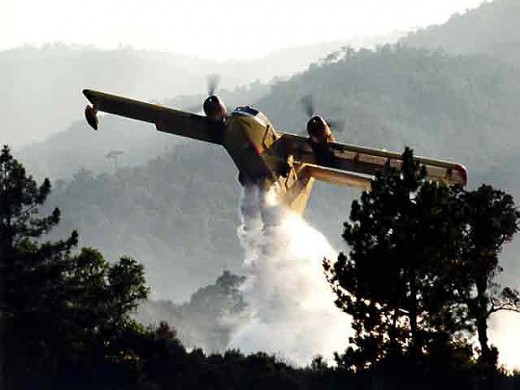
Airborne Bushfire Fighting is proven effective
But do Australian bushfire fighters reject such effective airborne options because (1) they seem overkill?,(2) because of prejudice against American/Canadian tech solutions?,
(3) State Government budget is so limited as to make them fanciful? (4) volunteer fire truck drivers can’t fly them so see their roles threatened?
In the most dangerous bushfire scenarios – remote ignitions – which is more effective fire trucks or these magnificent machines?
Airborne and ground force attack are not mutually exclusive; as in the military, they are critically interdependent.
.
But also more manoeuvrable water-bombing rotary-wing aircraft like the Erikson Aircrane plus the dropping in of RAFT crews also deserve consideration particularly in rugged terrain, where Bombardiers would not be able to achieve water-bombing runs low enough to be effective.
 Remote Ignitions: Prompt airborne suppression simply works! Remote Ignitions: Prompt airborne suppression simply works!
.
The cultural problem is that bushfire management is typically fire-truck centric in its thinking, planning and response. And beware of pollies and their devoted fans lobbying red herrings and porkies to try to stimie investigation into these options, when really the debate is simply one of cost.But research needs to precede any investment.
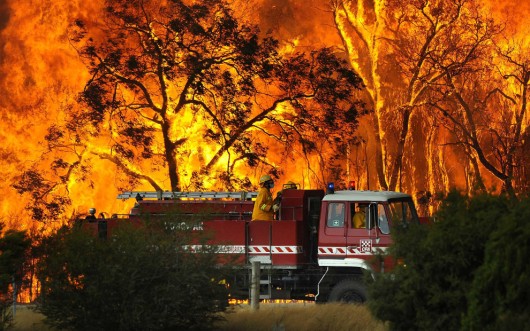 A fire truck moves away from out of control flames from a bushfire in the Bunyip Sate Forest near the township of Tonimbuk, 125 kilometers (78 miles) west of Melbourne, Saturday, Feb. 7, 2009. Walls of flame roared across southeastern Australia, razing scores of homes, forests and farmland in the sunburned country’s worst wildfire disaster in a quarter century. (Source: AP Photo, ^http://archive.boston.com/bigpicture/2009/02/bushfires_in_victoria_australi.html)
Fire trucks exposed to remote wildfire? What OH&S standard would permit this operation outside volunteer rural fire fighting? A fire truck moves away from out of control flames from a bushfire in the Bunyip Sate Forest near the township of Tonimbuk, 125 kilometers (78 miles) west of Melbourne, Saturday, Feb. 7, 2009. Walls of flame roared across southeastern Australia, razing scores of homes, forests and farmland in the sunburned country’s worst wildfire disaster in a quarter century. (Source: AP Photo, ^http://archive.boston.com/bigpicture/2009/02/bushfires_in_victoria_australi.html)
Fire trucks exposed to remote wildfire? What OH&S standard would permit this operation outside volunteer rural fire fighting?
.
Australia’s peak bushfire research organisation, Bushfire CRC, in its August 2006 report on the merits of aerial suppression made the following key findings:
.
- Aerial suppression can be effective in providing support to ground crews and improving the probability of first attack success by 50 percent or more. (so relies on fast detection of ignitions)
- For an aircraft to provide effective assistance it must be available at call, rapidly dispatched with minimal travel time and with logistical systems in place.
- Air operations effectively integrated into the incident management structure and competent personnel are needed to be available to direct the operations for good outcomes.
- The use of ground resources with initial aerial support is the most economically efficient approach to suppression.
- The use of aircraft for first attack until ground resources reach the fire produces the best suppression outcome.
- Large fixed wing air tankers such as a DC 10 are at a cost disadvantage. This is particularly the case for first attack when fires are small and where water drop accuracy is required. (…But no-one could argue that Victoria is now at a cost disadvantage without them..the economic bill alone is $2 Billion, which excludes the psychological, social and ecological costs).
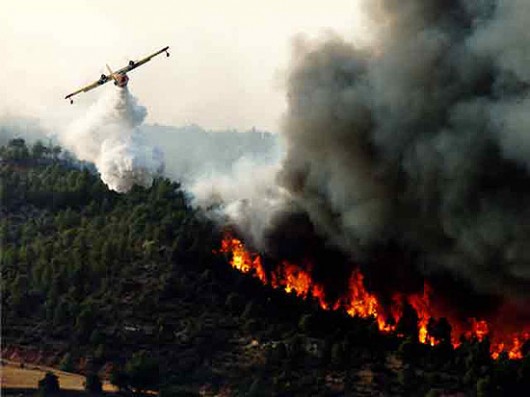
Standby Bombardier must be a first strike capability for bushfire fighting
…they are part of the performance solution, not the solution.
.
The airborne response to ignition suppression is just one strategy. The bushfire management solution is complex. To be effective in preventing a repeat of Victoria’s tragic and disgraceful 7-Feb-09, demands massive public investment and organisation at a level only national resources can muster. Don’t deny the legacy of Victoria’s 173 bushfire victims to be remembered as a recurring Armistice Day. It is unacceptable for governments to dismiss bushfire deaths as a fate of nature.
.
~ Tigerquoll, licensed commercial helicopter pilot, Suggan Buggan, Victoria.
.
Leave a Reply
You must be logged in to post a comment.
|
|
 ‘The Tarkine’ – 430,000 hectares of ancient Tasmanian forest
‘The Tarkine’ – 430,000 hectares of ancient Tasmanian forest Cradle Coast Authority (CCA), North West Tasmania’s map
as part of a tourism development strategy.
Cradle Coast Authority (CCA), North West Tasmania’s map
as part of a tourism development strategy.
 Moss-clad Sassafras (Atherosperma moschatum) trees in the Arthur River catchment near Waratah, Tarkine, Tasmania
(Photo © Ted Mead November 2003)
[Front Cover of the 2004 book, ‘Tarkine‘ edited by Ralph Ashton, and available from publishers Allen and Unwin,and just purchased by The Habitat Advocate.
Available at: ^http://www.allenandunwin.com/default.aspx?page=94&book=9781742372846]
Moss-clad Sassafras (Atherosperma moschatum) trees in the Arthur River catchment near Waratah, Tarkine, Tasmania
(Photo © Ted Mead November 2003)
[Front Cover of the 2004 book, ‘Tarkine‘ edited by Ralph Ashton, and available from publishers Allen and Unwin,and just purchased by The Habitat Advocate.
Available at: ^http://www.allenandunwin.com/default.aspx?page=94&book=9781742372846]
 This is how the ‘Tin Men‘ see the Tarkine… for its tin and tungsten.
(Source: Venture Minerals’ Mt Lindsay-Investor Presentation, Nov 2011)
This is how the ‘Tin Men‘ see the Tarkine… for its tin and tungsten.
(Source: Venture Minerals’ Mt Lindsay-Investor Presentation, Nov 2011)
 …and this is how the ‘Tin Men’ see the Tarkine… for the vast mining lease area they are happy to exploit and lay to waste.
…and this is how the ‘Tin Men’ see the Tarkine… for the vast mining lease area they are happy to exploit and lay to waste. …and this is how the Tin Men see the Tarkine – for its ‘Super Mining Profits’ … 30 to 55% return!
…and this is how the Tin Men see the Tarkine – for its ‘Super Mining Profits’ … 30 to 55% return! Corporate Miner ‘Metals X’ getting well stuck into a Tarkine rainforest hillside at nearby Mount Bischoff
Corporate Miner ‘Metals X’ getting well stuck into a Tarkine rainforest hillside at nearby Mount Bischoff
 The Tarkine is a refuge for healthy Tasmanian Devils to avoid the genocidal tumour disease
..but what could heartless commercial ‘Tin Men’ care?
Think of the ‘Super Mining Profits’ … 30 to 55% return!
The Tarkine is a refuge for healthy Tasmanian Devils to avoid the genocidal tumour disease
..but what could heartless commercial ‘Tin Men’ care?
Think of the ‘Super Mining Profits’ … 30 to 55% return!
 Nearby Mount Bischoff Tin Mine – wam, bam, thank you mam!
Nearby Mount Bischoff Tin Mine – wam, bam, thank you mam!

 The Tasmanian Minerals Council claims that there are “already enough layers of protection across the Tarkine region, where about 80% of the land has been put in multiple use reserves that allow mining“.
The Tasmanian Minerals Council claims that there are “already enough layers of protection across the Tarkine region, where about 80% of the land has been put in multiple use reserves that allow mining“. ‘Here at Melaleuca, six days’ walk from the nearest road,
such moments of peace are typically broken by bird calls,
including the distinct buzzing of the orange-bellied parrot’.
.
[Source: ‘Scientists Race To Rebuild Parrot Population’, by Peter Ker, Sydney Morning Herald, 20110207, ^http://www.globalanimal.org/2011/02/07/scientists-race-to-rebuild-parrot-population/29032/]
‘Here at Melaleuca, six days’ walk from the nearest road,
such moments of peace are typically broken by bird calls,
including the distinct buzzing of the orange-bellied parrot’.
.
[Source: ‘Scientists Race To Rebuild Parrot Population’, by Peter Ker, Sydney Morning Herald, 20110207, ^http://www.globalanimal.org/2011/02/07/scientists-race-to-rebuild-parrot-population/29032/]




































 Unprotected ancient native forests around Tasmania’s Recherche Bay
Unprotected ancient native forests around Tasmania’s Recherche Bay

































how much more of the planet do we really need to mine?this planet is mine too!
Bit over the top aren’t you?
Are Venture Minerals (the main company you seem to be attacking) trying to mine the entire 430,000 hectares? I suspect the operation would have a very small footprint and 99% of the area would be unaffected. It’s not just the 200 primary long-term workers who benefit – local businesses will see plenty of money spent with them to the profit of many local Tasmanians
Campbell,
What right does aggressive exploitation have in a ecologically precious and rare wilderness that is one of the few surviving homes to Tasmanian threatened species?
The jobs argument is as selfish as the profit argument. The jobs are short term, and most will be outsourced to non-Tasmanians. The profit goes back to Perth and overseas financiers.
…Leaving Tasmania’s natural wilderness asset destroyed. Wam bam thank you mam!
Bit 19th Century isn’t it?
“…Leaving Tasmania’s natural wilderness asset destroyed. Wam bam thank you mam!”
Yes – if they were mining the entire 430,000 hectares I would agree, but they’re not. Like I pointed out the mine footprint would be very small, thus only affecting a very small part of the Tarkine, leaving the rest of it as it was, threatened species unaffected. For this small price we get local employment, cash injection to local business, economic stimulus – all things the local economy desperatly needs you’d agree? I know a few people from Tullah that do!
The roads that have been developed through the area in the past have hardly destroyed the Tarkine – why would these small mines? They probably have a similar impact footprint.
Blanket bans over vast tracts of land is not the answer.
Tasmania has been more than 75% denuded of native forests. Pick on the denuded areas instead of raping the last virgin islands of pristine wilderness.
Tasmania’s mining legacy is Mt Lyell, Queenstown, Zeehan, Beaconsfield, Hellyer, Henty, Rosebery, Renison, Savage River and Avebury. Go taste the tailings!
Mining in Tasmania is selfishly destructive and offers no job security to Tasmanians, pillaging Tasmania for private wealth in Perth and overseas financiers.
Mineral Resources Tasmania and mining have no legitimacy in Tasmania.
Mining has the same 19th Century backward loser image of Kim Jong Un.
Wow that’s quite a vitriolic spiel. Dialogue like that only entrenches the general public’s views of causes like yours are being run by rabid militant greenies who wish to keep the country and its people in the Stone Age.
Drive a car do you? Own a computer? Have electricity in your home? All come from this mining you seem to so bitterly despise. Hypocrisy you think?
If you want to get the public on your side you need to tone down the rhetoric at touch I think, develop a more reasonable position on economic development and be willing to sit down with other groups and help develop a workable solution for all.
Campbell, publicise an Environmental Impact Statement on your proposed mine and provide a link to it, then we may continue on a level playing field.
Tearing a gaping series of holes in an remnant 50 million year old forest and so many jobs. Money for eight years is so shortsighted that it defies intelligence to even propose it, but dumping toxic tailings under strict enviromental conditions and the damage that has done worldwide may have lead to a blinkered approach to long term global devolution.